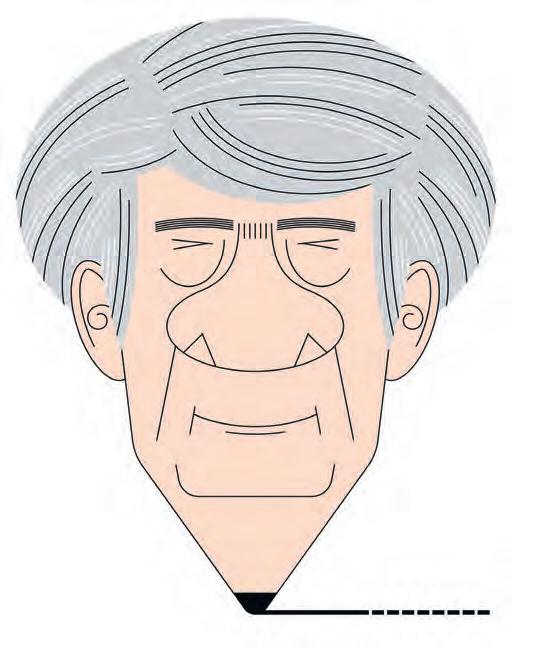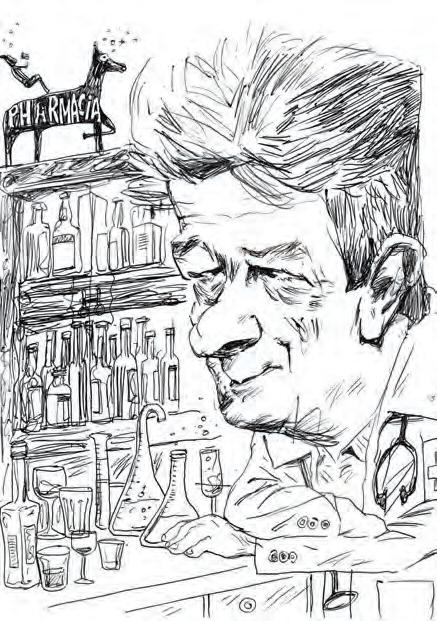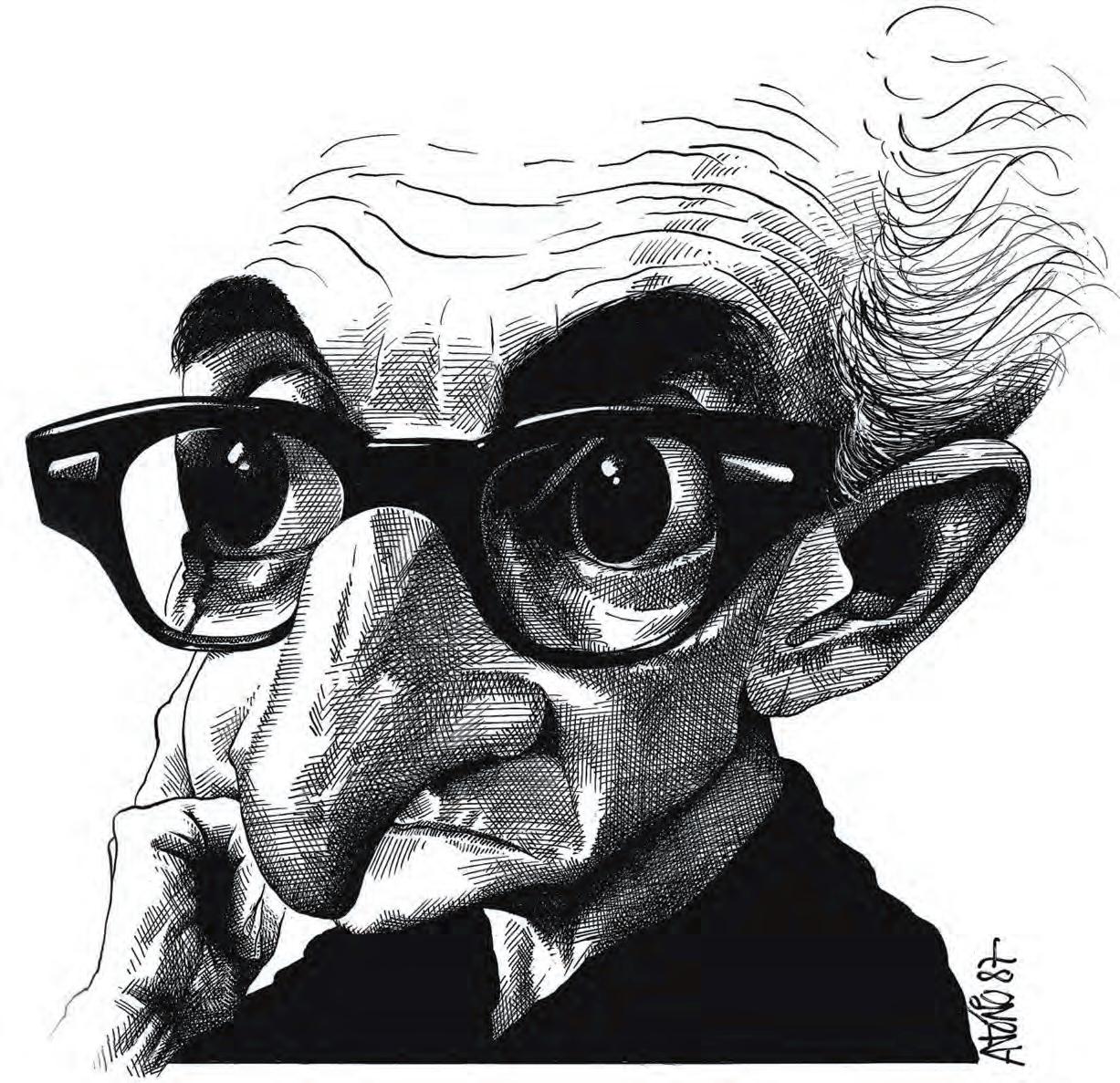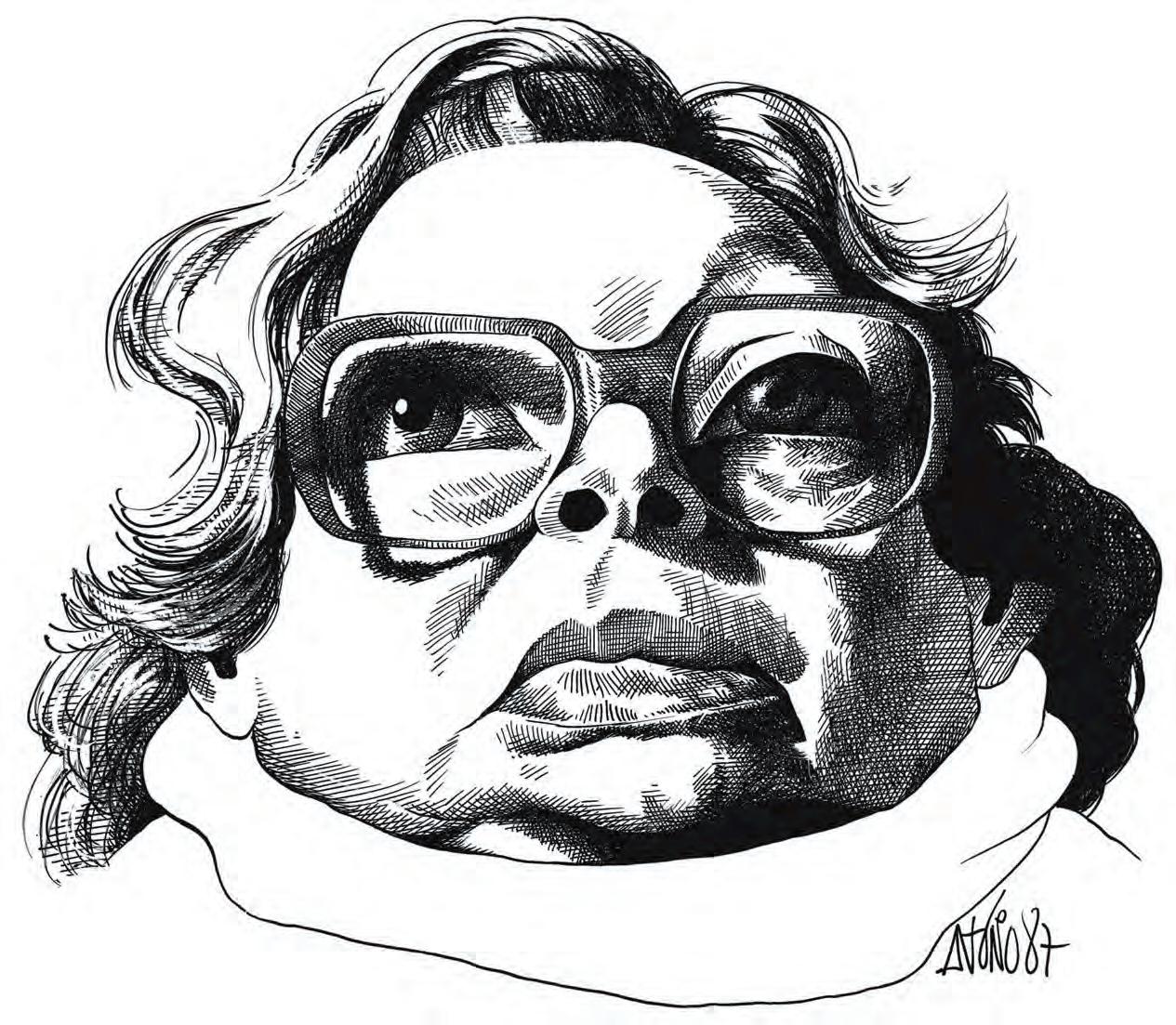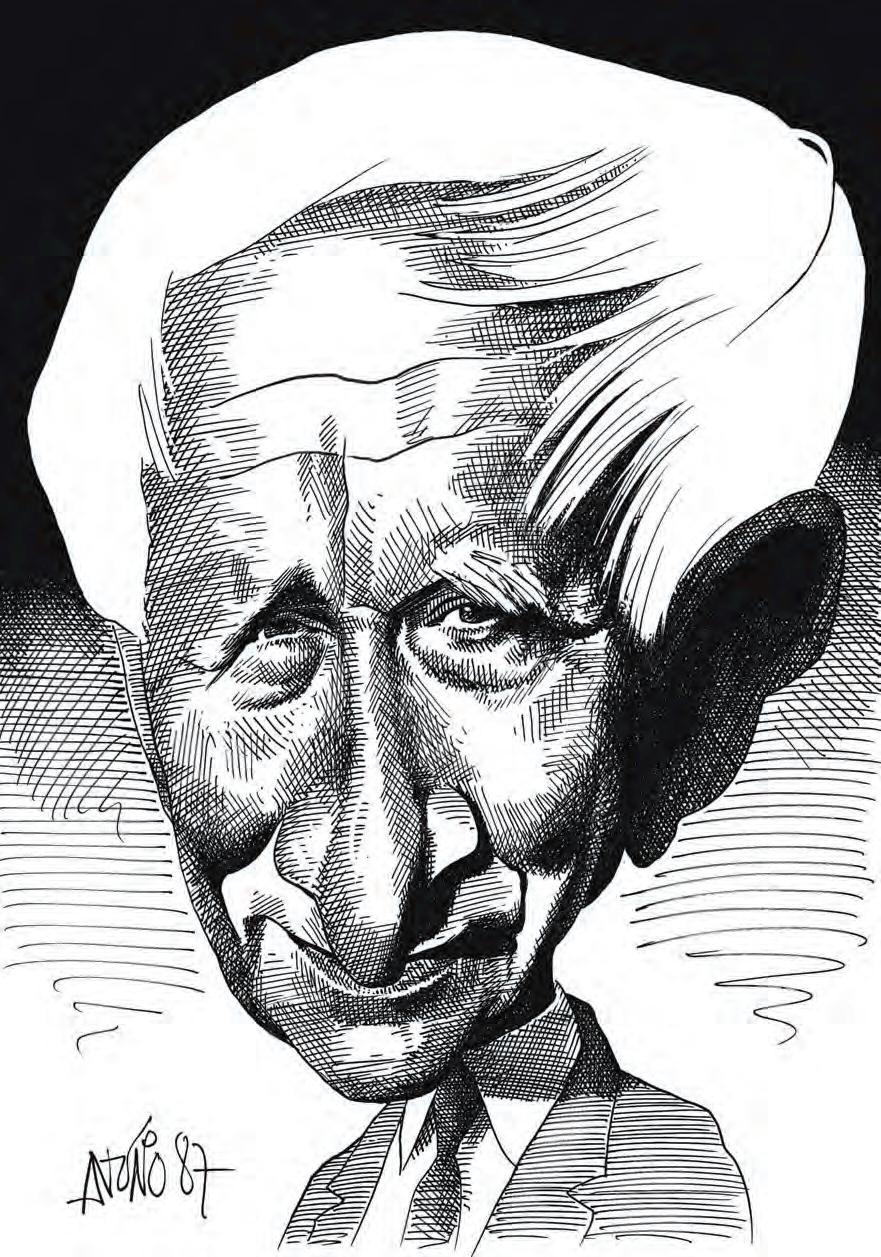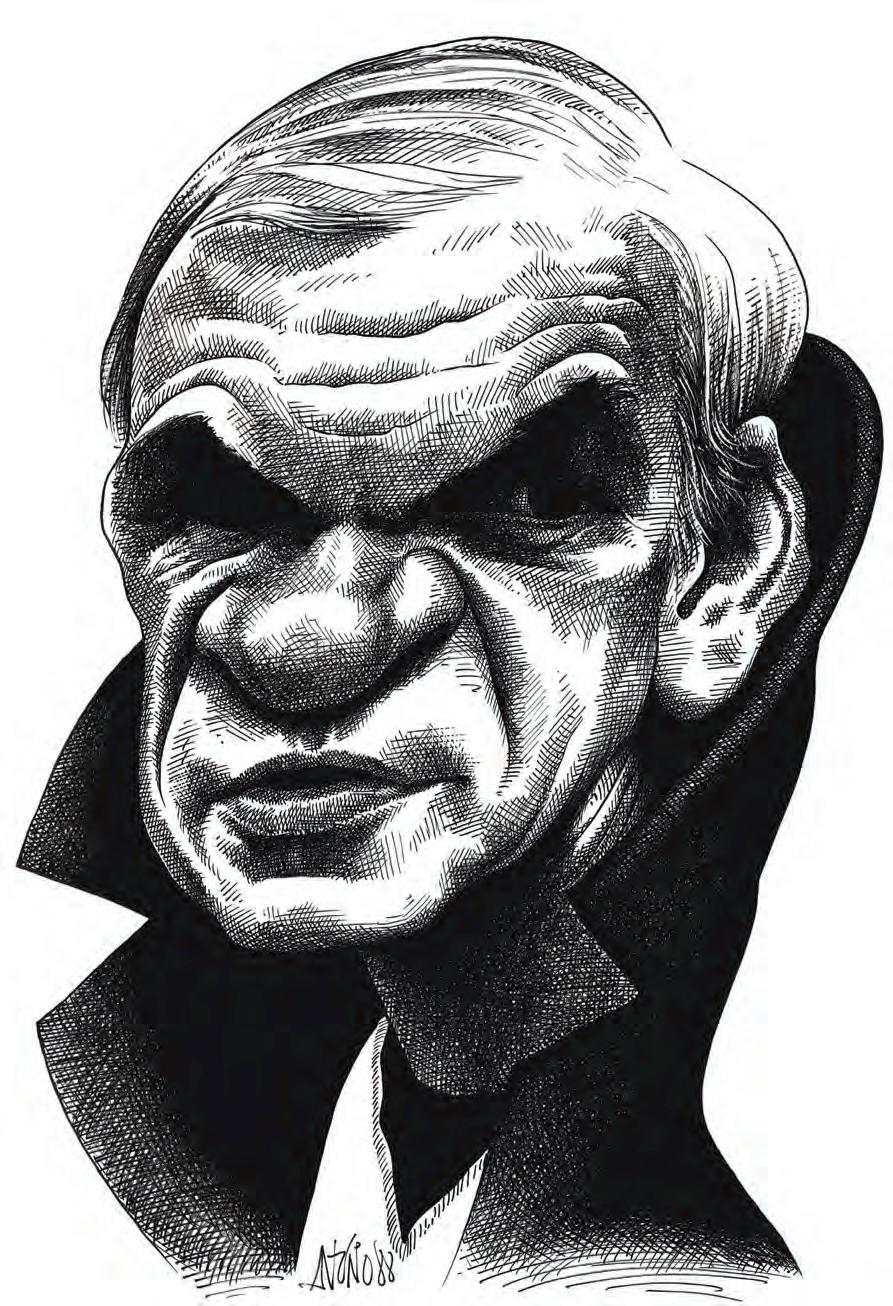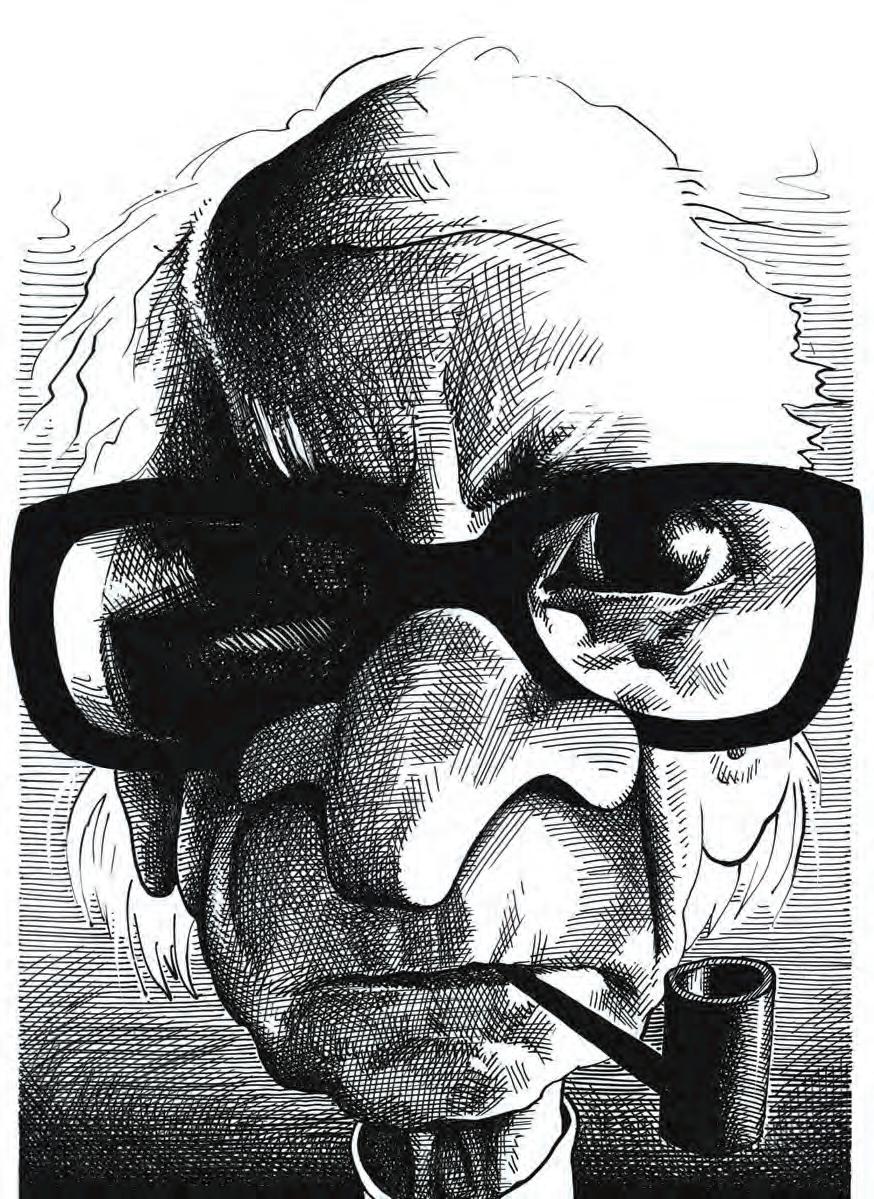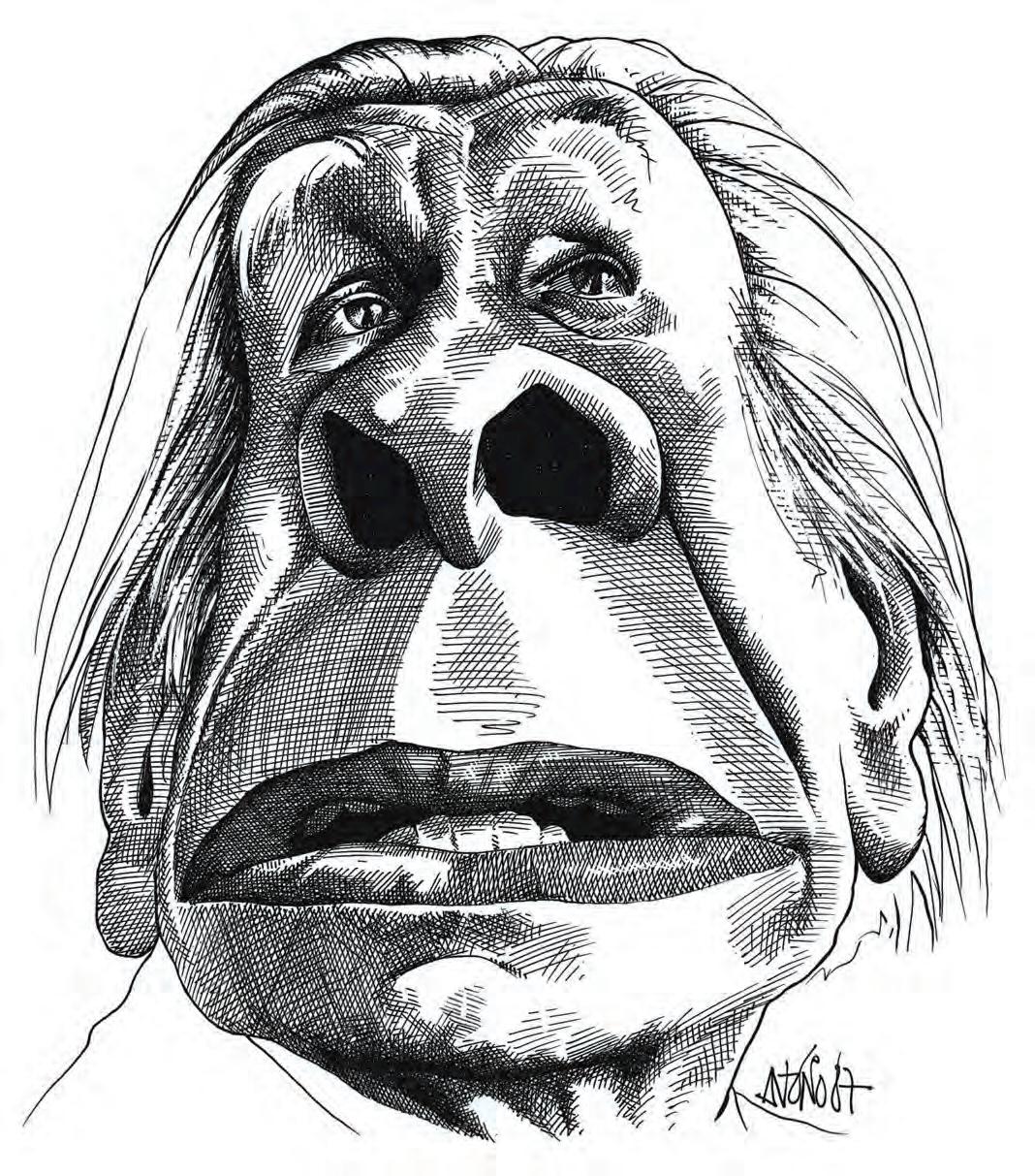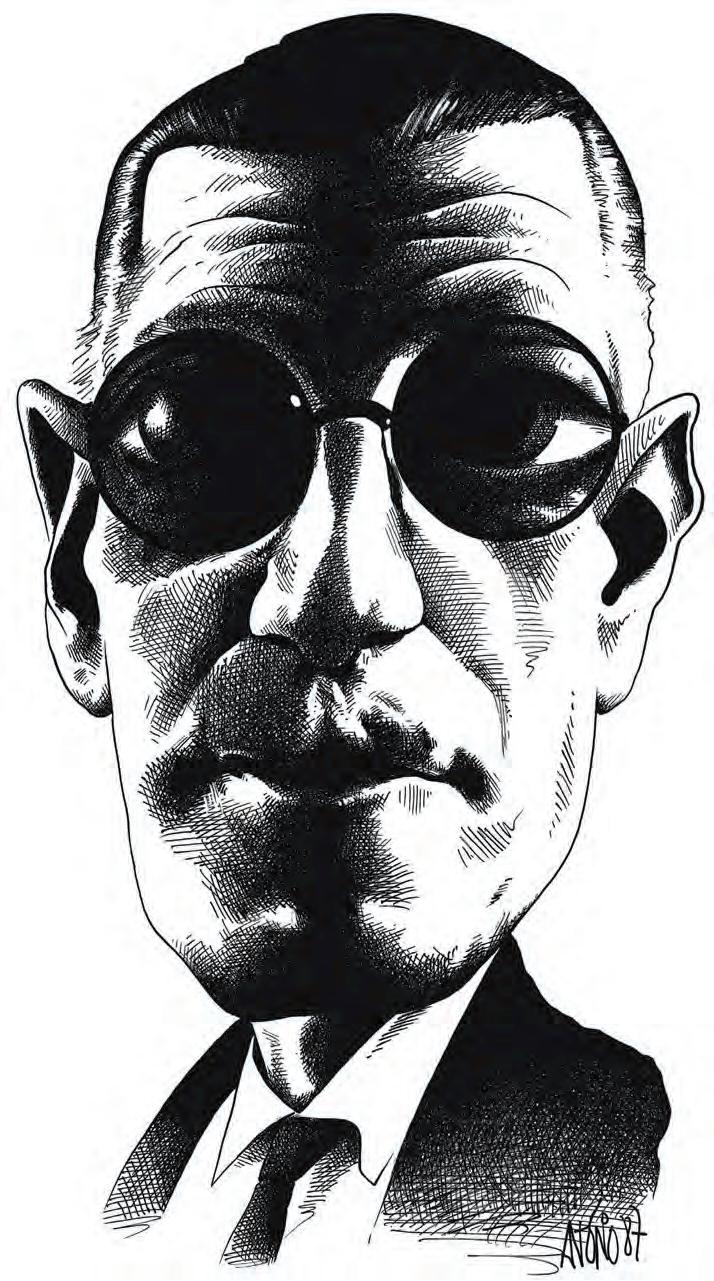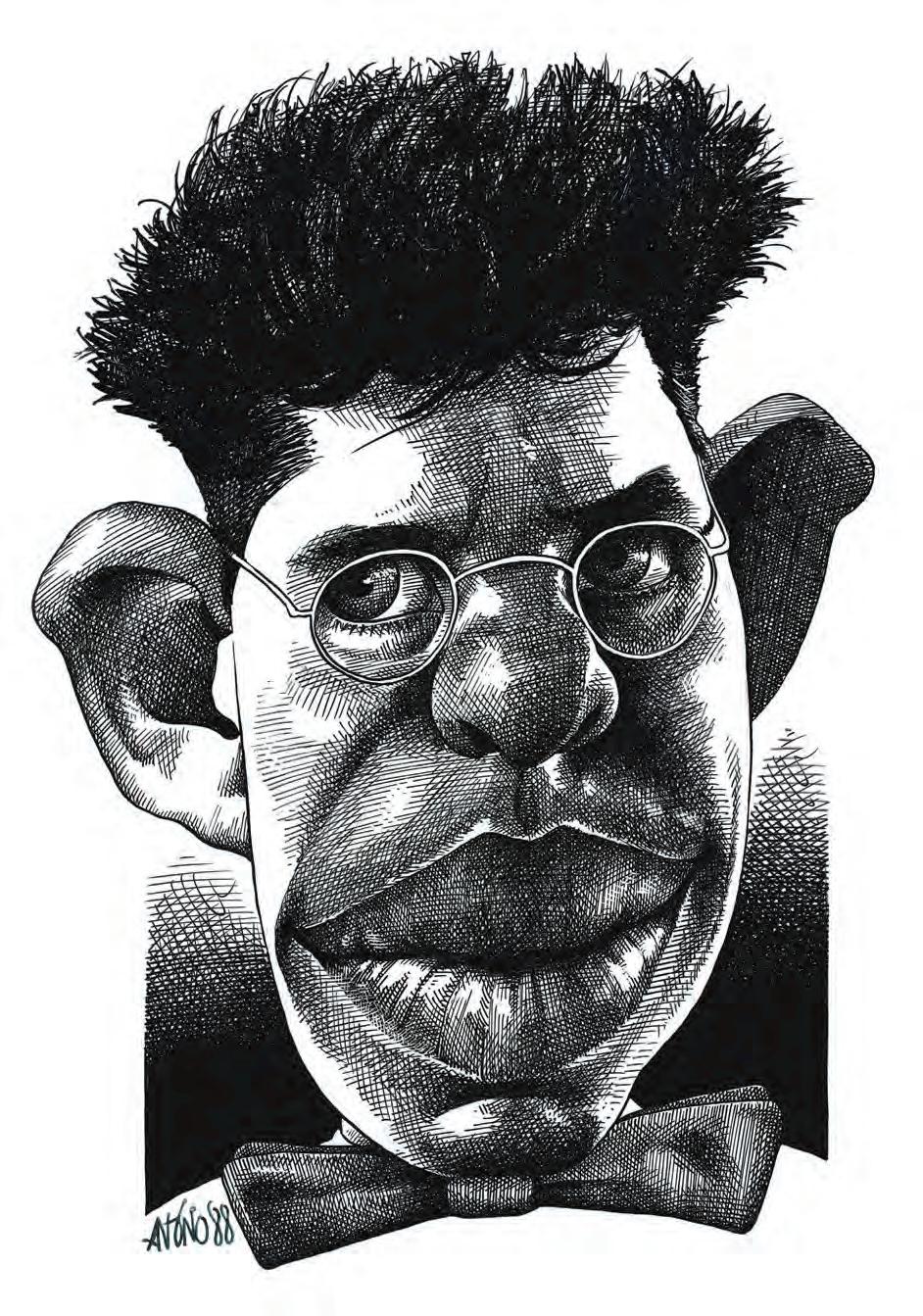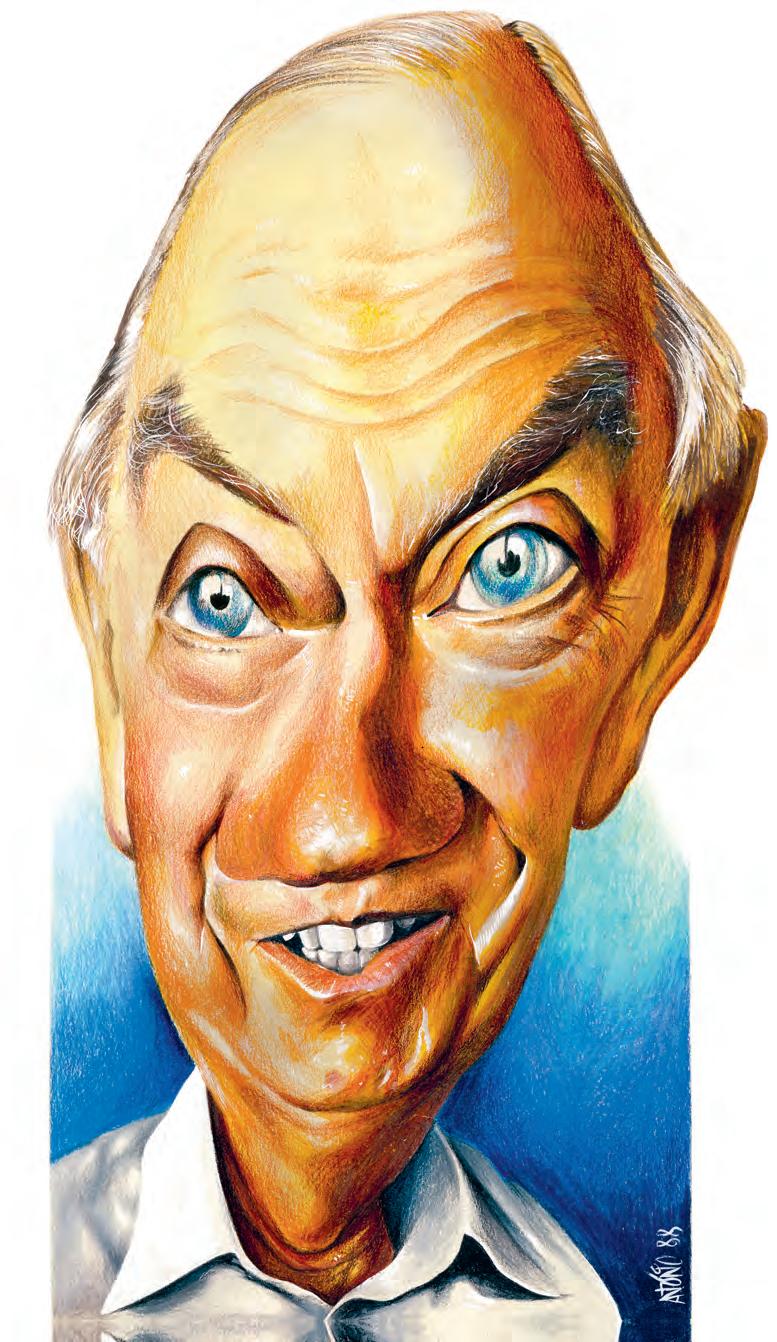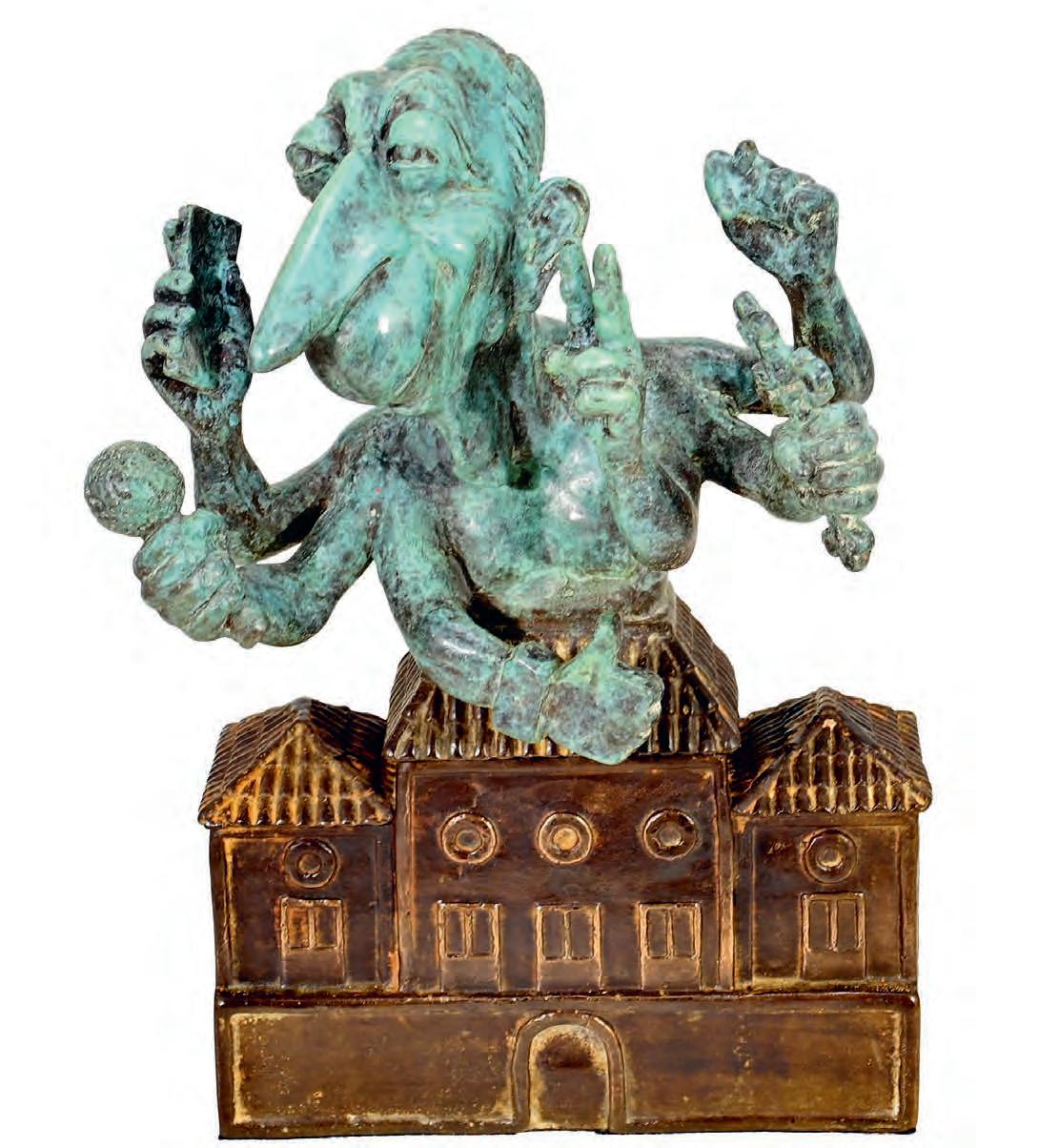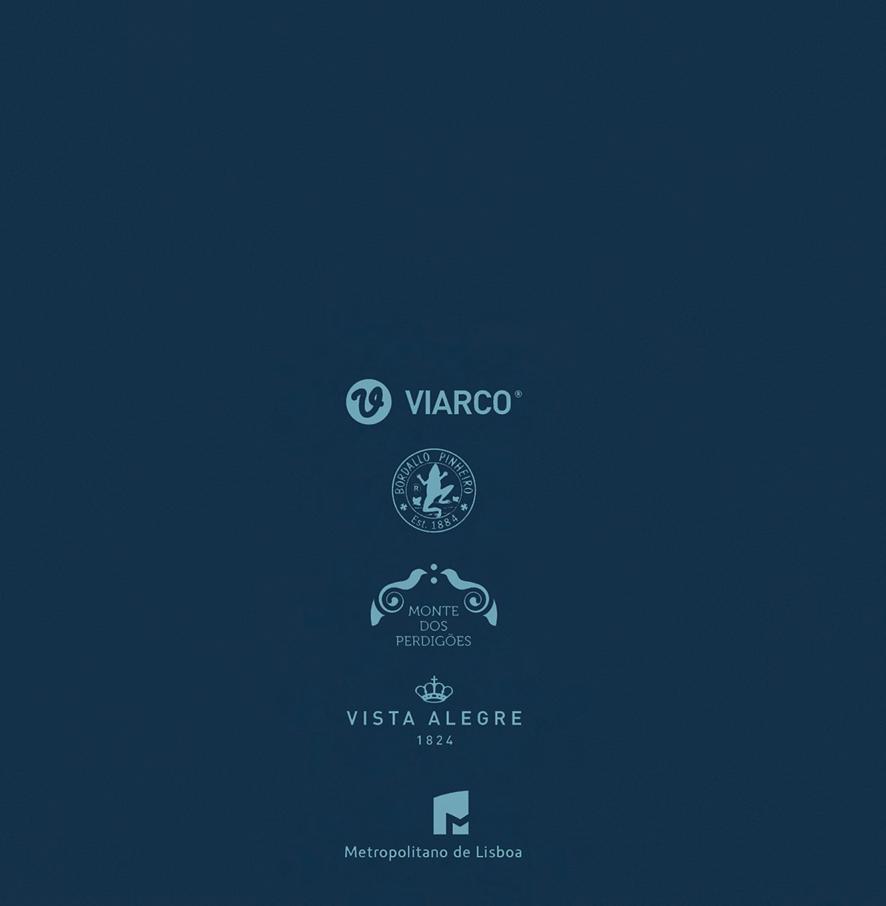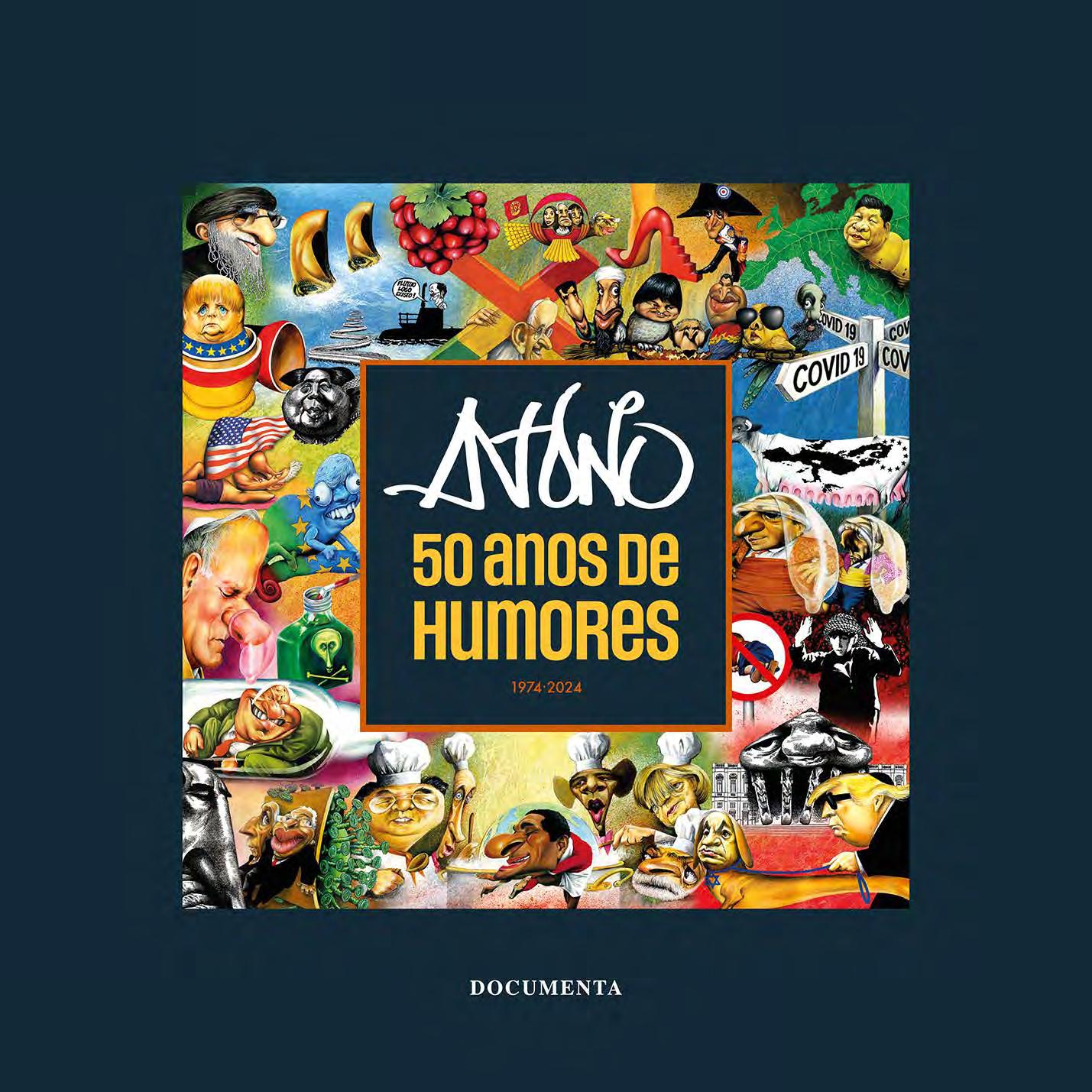
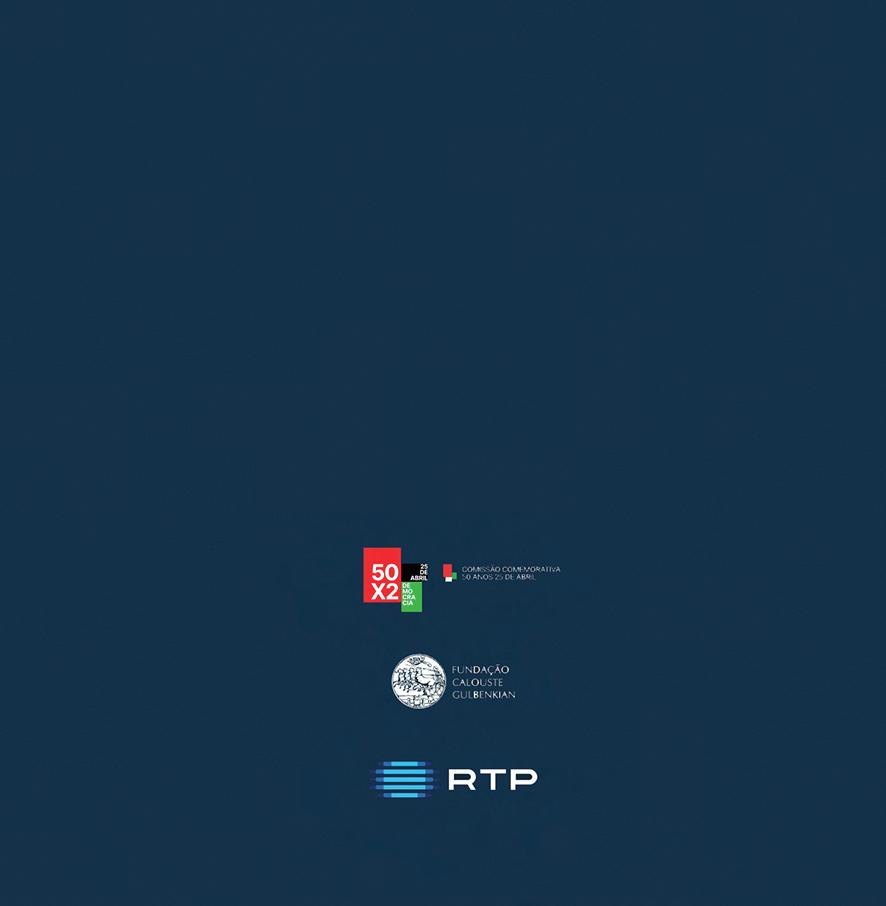

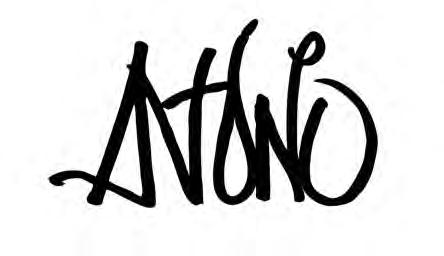
CÂMARA MUNICIPAL DE VILA FRANCA DE XIRA ANTÓNIO – 50 ANOS DE HUMORES
23 junho a 20 outubro 2024
Vila Franca de Xira
www.cm-vfxira.pt
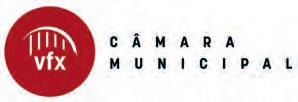

50 anos de humores
50 years of humours
Prefácios | Prefaces
MARCELO REBELO DE SOUSA
FERNANDO PAULO FERREIRA
GUILHERME D'OLIVEIRA MARTINS
DAVID SANTOS
HENRIQUE MONTEIRO
JOAQUIM VIEIRA
PEDRO MEXIA
RICARDO ARAÚJO PEREIRA
Comentários | Comments
JOSÉ ANTÓNIO LIMA

António não é só um grande retratista de pessoas e suas idiossincrasias.
António não é só um grande retratista de factos, situações e seus significados.
António não é só um grande observador de contextos e de tendências.
António não é só um analista de cinquenta anos de Portugal.
António não é só um decifrador de cinco décadas de universo.
António não é só um criador para um instante.
António não é só um cruzamento de passado, presente e futuro.
António não é só um cartoonista, um humorista, um escrutinador de personalidades, instituições e épocas, um provocador contra a ignorância, a estupidez, o medo ou a distração.
António é um mundo feito de milhões de mundos, tantos, tão variados e tão mutantes, que neles cabem todos, uns os que foram e já não são e os que ainda não são, mas serão.
Isso o torna, a si e à sua obra, perenes e ajuda a tornar perenes alguns que, de outra forma, nunca o seriam.
António is not just a great portraitist of people and their idiosyncrasies.
António is not just a great portraitist of facts, situations and their meanings.
António is not just a great observer of contexts and trends.
António is not just an analyst of fifty years of Portugal.
António is not just a decipherer of five decades of the universe.
António is not just a creator for a single moment.
António is not just an intersection of past, present and future.
António is not just a cartoonist, a humourist, a scrutiniser of personalities, institutions and epochs, a provocateur against ignorance, stupidity, fear or distraction.
António is a world made up of millions of worlds, so many, so varied and so changeable that everyone fits in, those who once were and no longer are and those who are not yet but will be.
This makes him and his work perennial and helps to become perennial some who would otherwise never be so.
MARCELO REBELO DE SOUSA Presidente da República Portuguesa | President of the Portuguese Republic
António, diz tudo.
A Revolução de 1974 perfaz em 2024 cinquenta anos, tantos quantos os da carreira de António, que nos oferece em cada semana o seu traço cirúrgico que resume, melhor do que mil palavras, os acontecimentos e personalidades que vão marcando o andamento do Mundo e do País.
Com as suas origens em Vila Franca, há um quarto de século que connosco organiza a exposição Cartoon Xira, onde cartoonistas nacionais e estrangeiros celebram a Liberdade de Expressão e o espírito crítico, usando o humor como arma de reflexão e crítica.
São tantos os seus desenhos que integram já a nossa identidade coletiva que António granjeou um lugar de destaque no espaço público português, surpreendendo-nos e divertindo-nos com a independência e acutilância que lhe são próprias.
Em Vila Franca de Xira, para além da presença regular dos seus cartoons , contamos ainda com uma belíssima escultura da sua autoria no caminho ribeirinho junto ao Tejo, representando Álvaro Guerra, outro conterrâneo também ligado à imprensa e à Liberdade (aliás, responsável pelo seu nome profissional, direto e sem necessidade de apelido: António diz, de facto, tudo).
António says it all.
The 1974 Revolution will be fifty years old in 2024, as many as António’s career. Every week he offers us his surgical drawing line that sums up, better than a thousand words, the events and personalities that are marking the course of the world and the country.

Sempre a partir do seu génio, António foi explorando outras expressões artísticas, entre as quais a cerâmica, dando conta do seu ecletismo e contemporaneidade.
Este livro, fruto da sua carreira fértil, foi corporizado também num conjunto de exposições em Vila Franca de Xira, que nos orgulharam tanto quanto nos orgulha o seu autor, com quem esperamos continuar a sorrir e a inquietar-nos por muitos anos.
With his origins in Vila Franca, we have been organising the Cartoon Xira exhibition for a quarter of a century, where national and foreign cartoonists celebrate Freedom of Expression and critical thinking, using humour as a weapon for reflection and criticism.
So many of his drawings have already become part of our collective identity; therefore, António has earned a prominent place in the Portuguese public space, surprising and amusing us with his unique independence and sharpness.
In Vila Franca de Xira, in addition to the regular presence of his cartoons, we also have a beautiful sculpture authored by him on the riverside path next to Tagus, depicting Álvaro Guerra, another fellow countryman also linked to the press and to Freedom (in fact responsible for his professional name, direct and without the need for a surname: In fact... António says it all).
Always based on his genius, António has been exploring other artistic expressions, among which ceramics, demonstrating his eclecticism and contemporaneity.
This book, a result of his fruitful career, has also been embodied in a series of exhibitions in Vila Franca de Xira, which made us as proud as we are of its author, with whom we hope to keep on smiling and unsettling ourselves for many years to come.
PAULO FERREIRA
Presidente da Câmara Municipal de Vila Franca de Xira | Mayor of Vila Franca de Xira
O traço do caricaturista é inconfundível. Quando relembramos cinquenta anos de comentário crítico de António através do desenho, encontramo-nos além de qualquer conformismo. No panorama internacional o reconhecimento da sua relevância, da qualidade e do rigor é indiscutível. É fácil encontrar a presença na imprensa internacional de prestígio. O nosso amigo Plantu tem insistido nesse ponto. A persistência dos seus argumentos de carácter e cor merece uma especial admiração. A independência de espírito e a liberdade crítica são marcas indeléveis da sua produção artística de observador implacável. Na história do jornalismo português, bem como na vivência da democracia portuguesa, que celebra meio século, António tem um lugar especial, pelo seu desassombro e pela sua originalidade. Nas páginas do Expresso encontramos, ao longo de cinco décadas, numa cadência regular, a sua presença, que se tornou imprescindível, desde as primeiras aparições, por exemplo com o «Kafarnaum», a preto-e-branco, até a incisivos comentários semanais, que se foram colorindo, incluindo os retratos impressivos, que se tornaram exemplares, das principais figuras marcantes do mundo cultural, político, económico e social, nacional e internacional. A extrema qualidade e o cuidado postos na execução das suas obras depressa se projetaram, colocando António, merecidamente, entre os melhores caricaturistas das últimas décadas num competitivo mundo global.
Pode dizer-se que António é hoje um digno sucessor do maior caricaturista português de sempre — Rafael Bordalo Pinheiro, que teve uma atividade extremamente profícua e multifacetada. E se podemos dispor de matéria-prima para um Álbum das Glórias dos tempos modernos é, com a criação de António, de um modo fecundo e único, que contamos. As caricaturas da estação Aeroporto do Metro de Lisboa constituem um exemplo marcante de uma das melhores produções de António, onde temos a representação das figuras mais relevantes da cultura portuguesa contemporânea. Pode mesmo dizer-se que as personalidades representadas permitem compreender os contributos mais decisivos para a construção da nossa identidade, na melhor tradição do
The drawing against indifference

The caricaturist’s line is unmistakable. When we look back on fifty years of António’s critical commentary through the drawing, we find ourselves beyond any conformism. On the international scene, the recognition of his relevance, quality and rigour is unquestionable. His presence in the prestigious international press is easy to find. Our friend Plantu has been insisting on this. The persistence of his arguments of character and colour deserves special admiration. Independence of spirit and critical freedom are indelible marks of his artistic production as a relentless observer. In the history of Portuguese journalism, as well as in the experience of Portuguese democracy, which is celebrating its half-century anniversary, António has a special place, both for his boldness and his originality. In the pages of Expresso we find at a steady pace, over the course of five decades, his regular presence, which has become indispensable, from the first appearances, for example with “Kafarnaum”, in black and white, to the incisive weekly commentaries, gradually more and more colourful, including the impressive portraits, which have become exemplary, of the main figures of the cultural, political, economic and social national and international world. The extreme quality and care put into the execution of his works quickly became known, deservedly placing António among the best cartoonists of recent decades in a competitive global world.
One can say that António is today a worthy successor to the greatest Portuguese caricaturist of all time — Rafael Bordalo Pinheiro, who had an extremely fruitful and multifaceted career. And if we can have raw material for a modern-time Album of Glories, it’s António’s creation, in a fruitful and unique way, that we can count on. The caricatures of Lisbon Metro’s Aeroporto Station are a striking example of one of António’s best productions, depicting the most important figures in contemporary Portuguese culture. One can even say that the personalities represented allow us to understand the most decisive contributions to the construction of our identity, in the best tradition of humour and picaresque. Like few others, the artist presented the notable Portuguese in a healthy critical tone that allows us to get to know each other better. And António revived the priceless figure of Zé Povinho1 created by Rafael Bordalo Pinheiro, depicting him in the description of our history with the caption: “Never getting up without laying down”. And José-Augusto França still adds with certainty: “Two cultures (...) can be assumed, in a country subject to the Pombaline2 and Jacobin centralisation
humor e do picaresco. Como poucos, o artista apresentou os portugueses notáveis em tom saudavelmente crítico que permite conhecermo-nos melhor. E António fez renascer a figura impagável de Zé Povinho, que Rafael Bordalo Pinheiro criou, representando na descrição da nossa História com a legenda: «Nunca se levanta que não se deite». E José-Augusto França diz certeiramente: «Duas culturas (...) podem ser supostas, num país sujeito à centralização pombalina e jacobina do Terreiro do Paço, Praça do Comércio com século e meio de perenidade política, económica e social. Nela o Zé Povinho, rural urbanizado à força, em trajo e espertezas, em certa medida, ditas saloias, alfacinha por não poder ser outra coisa, necessariamente frutificou, para além do espaço de vida do seu criador, numa multiplicação de vidas menores». No fundo, Zé Povinho resume a evolução cíclica da realidade portuguesa — entre a albarda e o manguito. E há sempre a predisposição para largar a primeira em nome da soberana negação pelo segundo, como resposta direta, sem nostalgias nem saudades — «Queres fiado? Toma!». As duas culturas são incindíveis. E António assume a atitude libertadora com o apelo severo à recusa da submissão. Por isso, Zé Povinho está pronto a levantar-se e a atirar os aparelhos ao ar. E Ramalho disse-o: «Um dia virá em que ele mude de figura e mude também de nome, para, em vez de se chamar Zé Povinho, se chamar simplesmente Povo».
O Zé Povinho vai, assim, regressando periodicamente na produção do caricaturista, para realizar comentários oportunos e para retratar os portugueses nos erros e defeitos, mas também no inconformismo. E é essa atitude contra a indiferença que sempre lhe encontramos. O humor faz parte da consciência cívica. E como afirmava Antonio Tabucchi, se os portugueses têm um fundo lírico e trágico-marítimo, não é possível conhecê-los, para além da sisudez, sem o picaresco e o anedótico. Para qualquer acontecimento ou para falar de determinada personagem da vida pública, surge imediatamente uma anedota ou um motivo para zombar... Eis porque é importante a produção de António e o seu sentido acutilante de humor, sobretudo quando é cáustico. Contra qualquer tentação pacificadora, a caricatura como exercício da livre expressão do pensamento e marca de desassossego é um fator fundamental para a vida da democracia e para a construção da cidadania. Eis porque cinquenta anos de humor e de sentido crítico são fundamentais. Parabéns, António! Longa vida à vitalidade justa da caricatura.
of Terreiro do Paço, Praça do Comércio3 with a century and a half of political, economic and social perpetuity. There, Zé Povinho, a forcefully urbanised rural in dress and smartness, to a certain extent said to be hillbilly, alfacinha4 for not being able to be anything else, necessarily fructified, beyond the living space of its creator, in a multiplication of lesser lives”. Deep down, Zé Povinho sums up the cyclical evolution of the Portuguese reality — between the saddle and the manguito5 . And there’s always a predisposition to drop the former in the name of sovereign denial for the latter, as a direct answer, without nostalgies nor longings — “Do you want it on credit? There you have it!”. The two cultures are inseparable. And António takes on the liberating attitude with a stern appeal to refuse submission. Therefore, Zé Povinho is ready to stand up and throw his gadgets into the air. And Ramalho said: “One day he will change his figure and also his name, so that instead of being called Zé Povinho, he will simply be called Povo (Folk)”.
Zé Povinho thus returns periodically in the caricaturist’s production, to make timely comments and to portray the Portuguese in their errors and defects, but also in their nonconformity. And it is this attitude against indifference that we always find in him. Humour is part of civic consciousness. And as Antonio Tabucchi said, if the Portuguese have a lyrical and tragic-maritime background, it’s not possible to know them, beyond their sternness, without the picaresque and the anecdotal. For any event or to talk about a certain character in public life, a joke or a reason to mock immediately arises... That’s why Antonio’s production and his sharp sense of humour is important, especially when it’s caustic. Against any pacifying temptation, caricature as an exercise of free expression of thought and a mark of unrest is a fundamental factor in the life of democracy and the construction of citizenship. That’s why fifty years of humour and critical sense are essential. Congratulations, António! Long live the just vitality of caricature.
1 – Zé Povinho is a satirical character of social criticism adopted as the personification of the Portuguese people, the equivalent of John Bull for the British and Uncle Sam for the North-American people.
2 – Pombaline relates to Marquês de Pombal, Prime Minister of King Joseph I.
3 – Terreiro do Paço, Praça do Comércio is the huge square where the most important ministries that govern the country are located.
4 – Alfacinha is the designation of a person from Lisbon.
5 – Manguito means “Iberian slap” or “forearm jerk” and is a sort of obscene gesture that communicates moderate to extreme contempt, being roughly equivalent in meaning to “fuck you” or “up yours”, having slightly the same meaning as showing the middle finger. To make the gesture, an arm is bent in an L-shape, with the fist pointing upwards; the other hand then grips or slaps the biceps of the bent arm as it is emphatically raised to a vertical position.
GUILHERME D'OLIVEIRA MARTINS
Administrador da Fundação Calouste Gulbenkian | Calouste Gulbenkian Foundation Administrator
António and his (our) Vila Franca
Diz o adágio popular que «o bom filho a casa torna». O seu significado remete para o regresso ao seio familiar daqueles que durante algum tempo se afastaram das suas raízes. De tantas vezes invocada, quase nos esquecemos do valor desta frase e do seu sentido existencial. A relação que estabelecemos com o local onde nascemos ou, sobretudo, crescemos e despertamos para a vida, nem sempre obedece ao desígnio de uma constância. Muitas vezes, a vida faz-se longe do lugar da nossa infância, mas na verdade o sentimento de pertença ou de uma identidade partilhada não nos abandona nunca, apesar das distâncias e do tempo desse afastamento.
Vem este preâmbulo a propósito da relação do cartoonista António com a sua terra natal: Vila Franca de Xira. Não que alguma vez tenha sido negada pelo artista ou pela cidade, mas essa ligação teve, de alguma forma, aspetos que nos remetem para a parábola aqui evocada. Entre Macau e Lisboa, nas viagens pela Europa e outras geografias continentais, António fez o percurso de alguém que voou atrás dos seus sonhos, em busca do reconhecimento nacional e internacional do seu trabalho artístico, o cartoon... Nessa medida, Vila Franca deu lugar ao mundo e teve de esperar pelo regresso de um dos seus filhos mais queridos e prestigiados.
Confirmando, semana a semana, nos últimos 50 anos, o valor do seu traço, António afirmou-se desde muito cedo como dos principais cartoonistas portugueses, alguém com fino recorte de análise política, traduzido em desenho de humor, que nas páginas do República, primeiro, e do semanário Expresso, depois, foi acompanhando o processo político da nossa Democracia, isto é, desde 1974, esse ano crucial, que marca um antes e um depois no nosso país. Este texto não pretende recuperar os muitos prémios e galardões que a carreira de António tem vindo a revelar, entre polémicas (como sempre acontece com o desenho crítico) e louvores de muitos daqueles (políticos, gestores, eclesiásticos e outros detentores do poder) que são alvo do seu lápis, da sua inteligência imagética. As palavras que aqui escrevo procuram antes de mais, identificar o lugar da cidade que o viu nascer na relação da sua afirmação enquanto caricaturista e ilustrador de atenta observação política.
Conhecida como uma das capitais da tauromaquia portuguesa, Vila Franca de Xira é ainda hoje mais lembrada pelos seus matadores de toiros (José Falcão, José Júlio, Mário Coelho e Victor Mendes) do que pelos seus artistas, escritores ou outros protagonistas. Porém, esse desequilíbrio começou a mudar quando António atingiu a polémica global com o seu desenho Preservativo papal (1993). Para lá dos toiros, e do escritor neorrealista Alves Redol ou ainda de Álvaro Guerra, Vila Franca começava então
The popular saying goes that “the good son returns home”. Its meaning refers to the return to the family home of those who have drifted away from their roots for some time. So often invoked, we almost forget the value of this phrase and its existential meaning. The relationship we establish with the place where we were born or, above all, where we grew up and woke up to life is not always one of constancy. Life often takes us far away from the place of our childhood, but in fact the feeling of belonging or of a shared identity never abandons us, despite the distances and the length of time we have been apart.
This preamble is about cartoonist António’s relationship with his hometown: Vila Franca de Xira. Not that it was ever denied by the artist or the city, but this connection had, in some way, aspects that bring us back to the parable evoked here. Between Macau and Lisbon, travelling through Europe and other continental geographies, António made the journey of someone who flew after his dreams, in search of national and international recognition for his artistic work, cartooning... To that extent, Vila Franca gave way to the world and had to wait for the return of one of its most beloved and prestigious sons.
Confirming week by week over the last 50 years the worth of his drawing lines, António established himself from a very early age as one of Portugal’s leading cartoonists, someone with a fine cut of political analysis translated into humorous drawings, which in the pages of República newspaper first and the weekly Expresso later, accompanied the political process of our Democracy, that is, since 1974, that crucial year that marks a before and after in our country. This text is not intended to recover the many prizes and awards that António’s career has garnered, between polemics (as is always the case with critical drawing) and praise from many of those (politicians, managers, ecclesiastics and other power holders) who are the target of his pencil, of his imagistic intelligence. The words I write here seek first of all to identify the place of the city that saw him being born in the relationship of his affirmation as a caricaturist and illustrator of attentive political observation.
Known as one of the capitals of Portuguese bullfighting, Vila Franca de Xira is still today remembered more for its bullfighters (José Falcão, José Júlio, Mário Coelho and Victor Mendes) than for its artists, writers or other protagonists. However, this imbalance began to change when António hit global controversy with his drawing Preservativo papal (Pope’s condom) (1993). Beyond the bullfights, the neorealist writer Alves Redol or also Álvaro Guerra, Vila Franca was then beginning to be recognised for the first time as the birthplace of a major artist. António and his worldwide scale put Vila Franca on the map and the merits lie with the cartoonist. Without the rise of his work and António’s international prestige, this small Ribatejo1 town would never have entered

a ser reconhecida, pela primeira vez, como berço de um artista maior. António e a sua escala mundial colocaram Vila Franca no mapa, e o mérito cabe ao cartoonista. Sem a ascensão do seu trabalho e o prestígio internacional de António, nunca esta pequena cidade do Ribatejo teria entrado no circuito artístico do cartoon ou do desenho de caricatura. Porém, quando o «bom filho» sentiu que a sua cidade, apesar de todos os afastamentos, morava ainda no seu coração, Vila Franca soube acolher, a partir do apoio da então Presidente da Câmara Municipal, Maria da Luz Rosinha, uma proposta de exposição coletiva, a Cartoon Xira, que, nos últimos 25 anos, tem feito da cidade a capital do cartoon português. De 1999 até hoje, por aqui passaram, sob a coordenação curatorial de António, não apenas os seus cartoons como os de muitos outros ilustradores portugueses (Augusto Cid, Vasco, André Carrilho, Cristina Sampaio, João Fazenda, António Maia, Pedro Silva, António Jorge Gonçalves, Bandeira, Daniel Garcia, Henrique Monteiro, Vasco Gargalo, Nuno Saraiva, Cristiano Salgado, Rodrigo de Matos, Gonçalo Viana e Carlos Brito) evocando os episódios políticos e sociais mais relevantes do ano anterior, como revista crítica e bem humorada. Para além dessa atenção particular ao quotidiano português, António passou a convidar desde 2009 um conjunto de caricaturistas internacionais de reconhecido mérito (Hermenegildo Sábat, Boligán, Cássio Loredano, Willem, Cécile Bertrand, Quino, Angeli, Turcios, Pawel Kuczynski, Cau Gomez, Marlene Pohle, Simanca e Chubasco, entre outros), ampliando assim a importância do desafio, bem como a sua repercussão na cidade e no país.
Esta será, por certo, uma das mais felizes ilustrações do provérbio «o bom filho a casa torna». E, na comemoração dos 50 anos da sua atividade criativa, a «casa» volta a recebê-lo, como sempre o tem feito, de braços abertos, nele reconhecendo não apenas um dos seus, como um dos mais distintos e extraordinários conterrâneos que Vila Franca viu nascer.
Enquanto vila-franquense, resta-me dizer: Obrigado, António.
the artistic circuit of cartooning or caricature drawing. However, when the “good son” felt that his city, despite all its distances, still lived in his heart, Vila Franca was able to welcome, with the support of the then Mayor Maria da Luz Rosinha, a proposal for a collective exhibition, Cartoon Xira, which over the last 25 years has made out of the city the capital of Portuguese cartooning. From 1999 to the present day, under António’s curatorial coordination, not only his cartoons but also those of many other Portuguese illustrators (Augusto Cid, Vasco, André Carrilho, Cristina Sampaio, João Fazenda, António Maia, Pedro Silva, António Jorge Gonçalves, Bandeira, Daniel Garcia, Henrique Monteiro, Vasco Gargalo, Nuno Saraiva, Cristiano Salgado, Rodrigo de Matos, Gonçalo Viana e Carlos Brito) have appeared here, evoking the most relevant political and social episodes of the previous year, as a critical and humorous magazine. In addition to this particular focus on Portuguese daily life, since 2009 António has invited a number of international cartoonists of recognised merit (Hermenegildo Sábat, Boligán, Cássio Loredano, Willem, Cécile Bertrand, Quino, Angeli, Turcios, Pawel Kuczynski, Cau Gomez, Marlene Pohle, Simanca and Chubasco, among others), thus expanding the importance of the challenge, as well as its repercussion in the city and the country.
This will certainly be one of the happiest illustrations of the proverb “the good son returns home”. And in celebrating 50 years of his creative activity, his “home” welcomes him back, as it always has, with open arms, recognizing in him not only one of its own, but also one of the most distinguished and extraordinary countrymen that Vila Franca has seen born.
As Vila Franca de Xira countryman, I can only say: Thank you, António.
DAVID SANTOS
Historiador de Arte | Art Historian
Nota biográfica
António (António Moreira Antunes) nasceu em Vila Franca de Xira em 12 de abril de 1953.
Tem o curso de Pintura da Escola Artística António Arroio, de Lisboa. Iniciou-se no cartoonismo em 16 de março de 1974 no jornal República e é colaborador permanente do semanário Expresso desde o final de 1974.
Dos prémios recebidos, destacam-se:
Grande Prémio do XX International Salon of Cartoons (Montreal, Canadá, 1983);
1.° Prémio de Cartoon Editorial do XXIII International Salon of Cartoons (Montreal, Canadá, 1986);
Prémio Gazeta de Cartoon (Lisboa, Portugal, 1992);
Grande Prémio de Honra do XV Festival du Dessin Humoristique (Anglet, França, 1993);
Award of Excellence — Best Newspaper Design, SND (Estocolmo, Suécia, 1995);
Premio Internazionale Satira Politica (ex æquo) (Forte dei Marmi, Itália, 2002);
Grande Prémio Stuart Carvalhais (Lisboa, Portugal, 2005);
Prix Presse Internationale (Saint-Just-le-Martel, França, 2010);
Prémio Gazeta de Mérito (Lisboa, Portugal, 2018).
Realizou exposições individuais em Portugal, Brasil, Alemanha, Espanha, França, Luxemburgo, Bélgica, China e Holanda.
Integra as antologias: The 1970s, Best Political Cartoons of the Decade, McGraw-Hill, PaperBacks, Nova Iorque; The Finest International Political Cartoons of Our Time, Wittyworld Books, EUA, 1992; The Finest International Political Cartoons of Our Time II, Wittyworld Books, EUA, 1993; The Finest International Political Cartoons of Our Time III, Wittyworld Books, EUA, 1994; Cartoonometer, Wittyworld Books, EUA, 1994; C'est Fôte à Bruxelles!, Centre Wallonie-Bruxelles, Paris, França, 2010.
Autor de Figuras de Lisboa, 50 caricaturas de personalidades relevantes da vida política, cultural e artística da cidade, realizadas em pedra encastrada, que constituem a animação plástica da estação Aeroporto do Metro de Lisboa.
É curador da Cartoon Xira e diretor do World Press Cartoon.
Condecorado em 2005, pelo presidente da República Portuguesa, Jorge Sampaio, com a Ordem do Infante Dom Henrique, no grau de Grande-Oficial.
Medalha de Mérito Municipal de Valor Cultural — Dourada/2019 Câmara Municipal de Vila Franca de Xira.
Condecorado, em 2023, pelo presidente da República Portuguesa, Marcelo Rebelo de Sousa, com a Ordem da Liberdade, no grau de Comendador.
Biography
António (António Moreira Antunes) was born in Vila Franca de Xira, Lisbon, Portugal, on April 12, 1953.
He has a course in Painting from the specialised Artistic School António Arroio, Lisbon. Started cartooning in March 1974 in the newspaper República and has been a resident cartoonist for the weekly newspaper Expresso since late 1974.
Of the awards received, the following stand out:
Grand Prix of the XX International Salon of Cartoons (Montreal, Canada, 1983), 1st Cartoon Editorial Award at the XXIII International Salon of Cartoons (Mon treal, Canada, 1986),
Gazeta Cartoon Prize (Lisbon, Portugal 1992),
Grand Prize of Honor of the XV Festival of Humorous Drawing (Anglet, France, 1993),
Award of Excellence — Best Newspaper Design, SND (Stockholm, Sweden 1995), International Prize for Political Satire (ex aequo) — (Forte dei Marmi, Italy, 2002),
Great Prize Stuart Carvalhais (Lisbon, Portugal 2005), Prix Presse Internationale (Saint-Just-le-Martel, France, 2010), Gazeta de Mérito Prize (Lisbon, 2018).
He has held solo exhibitions in Portugal, Brazil, Germany, Spain, France, China and the Netherlands.
He was part of the anthologies: The 1970s, Best Political Cartoons of the Decade (McGraw-Hill, Paper Backs, New York, USA). The Finest International Political Cartoons of Our Time (Wittyworld Books, USA, 1992). The Finest International Political Cartoons of Our Time II (Wittyworld Books, USA, 1993). The Finest International Political Cartoons of Our Time III (Wittyworld Books, USA, 1994). Cartoonmeter (Wittyworld Books, USA, 1994). C'est Fôte à Bruxelles! (Centre Wallonie-Bruxelles, Paris, France, 2010).
Author of the set Lisbon Figures, of 50 caricatures of relevant personalities of the city’s political, cultural and artistic life, made in recessed stone. that plastically animate the Aeroporto Station of the Metropolitano de Lisboa. He is curator of the Cartoon Xira Festival and director of the World Press Cartoon Salon.
He was decorated in 2005 by the President of the Portuguese Republic, Jorge Sampaio, with the Order of Infante Dom Henrique, in the rank of Grand Officer. Gold Municipal Merit Medal for Cultural Value — 2019 Vila Franca de Xira Municipal Council.
He was decorated in 2023, by the President of the Portuguese Republic, Marcelo Rebelo de Sousa, with the Order of Freedom, in the degree of Commander.


Um país a traço fino
Não sei se o país merece o António que tem, mas tenho a certeza de que o António merece este país. Com outro, menos animado, menos remexido e ciclotímico, o seu traço ficaria prejudicado. Como juntar o estilo, o génio e o humor a um país certinho, planeado, organizado e repleto de boas leis e regras? Deve ser difícil, mas, felizmente para António, o país recompensa-lhe a arte com acontecimentos extraordinários, estrambólicos, diria, que são como modelos nus para um pintor clássico.
No início da carreira, por acaso a 16 de março de 1974, data da incursão que veio das Caldas da Rainha e acabou mal para os militares, ao contrário do que passaria um mês e pouco depois, com o 25 de Abril, António teve logo a sorte de ser presenteado com um clima político confuso, muito favorável a quem gosta de ver a realidade de forma distanciada, no sentido de não empenhada clubisticamente (o Benfica é outro assunto). Talvez por isso, António tornou-se, para mim, indispensável com a série «Kafarnaum», há 49 anos. Era uma banda desenhada, que aparece nos desenhos selecionados de este álbum e que se prolongou por 100 episódios.
Depois, quando o cartoon se torna uma peça autónoma e central no Expresso, todo o talento de António fica claro. Por um lado, nunca se repete, ao contrário do geral dos cronistas; por outro, as suas citações dos clássicos são pequenas maravilhas, obras-primas contemporâneas (veja-se a rendição do Carmo, ao estilo Velázquez, a lição de anatomia, ao estilo Rembrandt, ou Manuel Alegre e Mário Soares, ao estilo Malhoa). Naturalmente, os seus alvos mais constantes são os grandes políticos. Eanes, Soares, Sá Carneiro, Álvaro Cunhal, Freitas do Amaral, Mota Pinto, Paulo Portas e todos os que foram membros de governo e dirigentes dos maiores partidos são objeto de interpretações que os colocam nas mais diversas situações — viúvas carpideiras, reincarnações de King Kong, anjinhos, ceifeiros ou carregadores de riquexó.
A finely-drawn country
I don’t know if the country deserves the António it has, but I’m sure that António deserves this country. With another country, a less lively one, less messy and less cyclothymic, his drawing style would be jeopardised. How can style, genius and humour be brought together in a country that is perfect, planned, organised and with plenty of good laws and rules? It must be difficult, but fortunately for António, the country rewards his art with extraordinary events, I would rather say bizarre, that are like nude models for a classical painter.
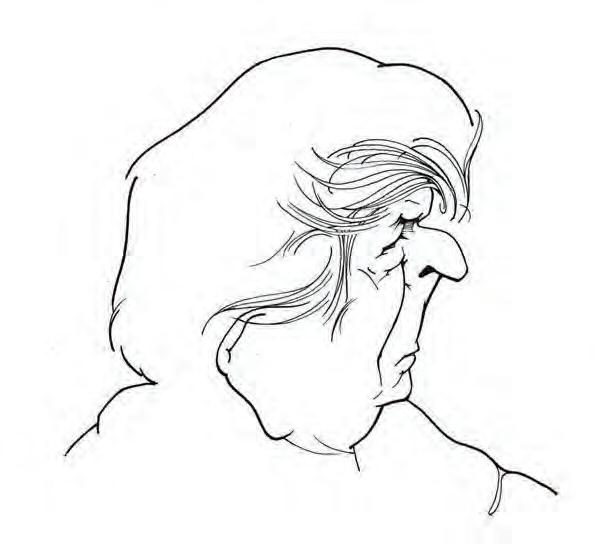
Os períodos históricos também se tornam mais compreensíveis, olhando agora para trás, através do traço de António. Do muito que já tinha esquecido, recordei ao revisitar estes cartoons Também o efeito que o humor inteligente provoca sobre o meu corpo mantém-se , mesmo ao fim de, por vezes, tantos anos, como quando Marx (Groucho) tem de sair do filme que Soares realiza, devido à intervenção do FMI (as crises económicas são oportunidades, também, para o humor); ou se confirma o estilo absolutamente camaleónico (a imagem não deixa dúvidas) do ministro Centeno; ou na fotografia de família do Governo de Passos Coelho, onde todos parecem evitar que haja qualquer memória futura dos cortes que fizeram.
Mas, perguntarão, e o preservativo no nariz do Papa? Sim, foi em 1992, há 32 anos, e ninguém esquece. Não pela iconoclastia ou por algum insulto que dele se retire. Mas pela genialidade. Nem toda a gente percebeu o significado de desenhar o chefe da Igreja Católica com um preservativo no nariz, porque quase todos quiseram ver para
At the beginning of his career, by chance on 16 March 1974, the date of the incursion that came from Caldas da Rainha and ended badly for the military, unlike what would happen a month and a bit later, with the 25 April, António was lucky enough to be immediately gifted with a confusing political climate, very favourable to those who like to see reality from a distance, in the sense of not being club-wise committed (Benfica is another matter). Perhaps that’s the reason why António became indispensable to me with the “Kafarnaum” series, 49 years ago. It was a comic strip, which appears in the selected drawings in this album and which ran for 100 episodes.
Later, when the cartoon became an autonomous and central piece in Expresso newspaper, António’s talent became clear. On the one hand, he never repeats himself, unlike most chroniclers; on the other, his quotes from the classics are little wonders, contemporary masterpieces (see the rendition of Carmo barrack, in Velázquez style, the anatomy lesson, in Rembrandt style, or Manuel Alegre and Mário Soares, in Malhoa style). Naturally, his most constant targets are the great politicians. Eanes, Soares, Sá Carneiro, Álvaro Cunhal, Freitas do Amaral, Mota Pinto, Paulo Portas and all those who were members of a government and leaders of the major political parties are the subject of interpretations that place them in the most diverse situations — mourning widows, reincarnations of King Kong, little angels, reapers, or rickshaw carriers.
Looking back now, historical periods also become more intelligible through António’s drawing lines. When I revisited these cartoons, I recalled much of what I had forgotten. Also, the effect that intelligent humour produces on my body remains, sometimes even after so many years, like when Marx (Groucho) was forced to leave the film Soares was directing as a result of thea intervention of the IMF (economic crises are also opportunities for humour); or when the absolutely chameleonic style (the image leaves no doubt) of Minister Centeno is confirmed; or in the family photo of Passos Coelho’s government, where everyone seems to avoid any future memory of the budgetary cuts they made.
But you might ask, what about the condom on the Pope’s nose? Yes, it was in 1992, 32 years ago and no one will forget it. Not because of the iconoclasm or any insult coming therefrom. But for its geniality. Not everyone understood the meaning of drawing the head of the Catholic Church with a condom on his nose, because almost everyone wanted to see beyond what was there. And the message — apart from the drawing line,
além do que lá estava. E a mensagem — para além do traço, como sempre rigoroso — é o mais simples que existe: não se deve meter o nariz onde não se é chamado. Ou seja, o Papa escusava de ter uma mensagem radical contra a proteção sexual no tempo em que a SIDA era praticamente uma sentença de morte. Além de sensato, foi premonitório. Dois papas depois, o chefe da Igreja, Papa Francisco, admite situações em que a proteção é melhor do que ausência dela.
Além destes desenhos mais icónicos e de acontecimentos, como a adesão à Europa (o Zé Povinho à boleia da CEE), que são inesquecíveis para quem viveu esses anos, outros episódios existem em que são os cartoons que nos avivam a memória: a clonagem da ovelha Dolly, na versão de Guterres, primeiro-ministro, e Marcelo, líder da oposição; as possíveis dioptrias de Constâncio, então Governador do Banco de Portugal, face aos escândalos sucessivos na banca; Sócrates com um nariz formado por notas de euro; o presidente do falido BES, Ricardo Salgado, a fugir de Portugal com uma mala com o formato do país, ou não fosse ele conhecido como o DDT (Dono Disto Tudo); Jerónimo de Sousa numa estátua de estilo coreano, acompanhado pelo líder da Coreia de Norte, depois de ter recusado que em Pyongyang exista uma ditadura dinástica.
É impossível descrever todos os assuntos da política nacional que António criticou com o seu traço. Fiquemos pelo mais recente: a formação da AD, com Montenegro à viola, Nuno Melo à guitarra e o fadista Câmara Pereira (por acaso de boca fechada).
Estes 50 Anos de Humores são obra indispensável para conhecermos o meio século passado, que não fica atrás, pelo contrário, em minha opinião, do Álbum das Glórias do também grande Rafael Bordalo, no século XIX. António tem o reconhecimento nacional e internacional; tem a Ordem da Liberdade, tem os prémios todos (ou quase) que um cartoonista pode ter. Para mim foi um enorme orgulho tê-lo no jornal onde trabalhei e colaboro há 35 anos e do qual fui diretor e subdiretor durante 15. Muitas vezes falámos sobre os seus trabalhos e algumas vezes tive de aturar quem não os compreendia, ou apenas acha graça ao que não é com ele. Porém, só uma vez António me trouxe um dissabor: quando fizemos equipa num rally paper (há bem mais de 20 anos e juntamente com o nosso grande amigo e camarada João Garcia) e não ganhámos porque o António não desenhou com exatidão o brasão da Nunciatura Apostólica. Velho camarada, há vinganças que se servem muito frias e aqui tens uma: tu que tens o melhor traço, o desenho exato, o exagero requerido pela caricatura no ponto certo, logo havias de te enganar nessa altura, num somenos de importância para ti. Porém, para mim, estava em causa a única prova, mais ou menos desportiva, que podia ter ganho... Não se faz!
rigorous as ever — is as simple as this: you shouldn’t stick your nose where it doesn’t belong. In other words, there was no need for the Pope to have a radical message against sexual protection at a time when AIDS was practically a death sentence. As well as being wise, it was premonitory. Two popes later, the head of the Church, Pope Francis, admits to situations in which protection is better than no protection at all.
In addition to these more iconic cartoons and events, such as the accession to EU (Zé Povinho1 hitching a ride on the EEC), which are unforgettable for those who lived through those years, there are other episodes where the cartoons jog our memories: the cloning of Dolly the sheep, in the version of Guterres, Prime Minister, and Marcelo, Leader of the Opposition; the possible dioptres of Constâncio, then Governor of the Bank of Portugal, in the face of successive banking scandals; Sócrates with a nose made up of euro notes; the chairman of the bankrupt BES bank, Ricardo Salgado, fleeing Portugal with a suitcase in the shape of the country, or had he not been known as DDT (Dono Disto Tudo [Owner of It All]); Jerónimo de Sousa in a Korean-style statue, accompanied by the leader of North Korea, after having denied that Pyongyang has a dynastic dictatorship.
It is impossible to describe all the issues concerning national politics that António has criticised with his drawing lines. Let’s stick to the most recent one: the formation of AD2 , with social democrat Montenegro on viola, Christian-democrat Nuno Melo on guitar and the monarchist fado3 singer Câmara Pereira (with his mouth closed, by chance). This collection concerning 50 Years of Humours is indispensable to get us to know the past half-century, which, in my opinion, is not standing behind the Album of Glories by the also great Rafael Bordalo, in the 19th century. António has national and international recognition; he has received the Order of Liberty award and all the awards (or almost all) a cartoonist can receive. I was very proud to have him at the newspaper where I’ve worked and collaborated for 35 years and where I’ve been director and deputy director for 15 years. We have often talked together about his works and I had sometimes to put up with people who didn’t understand them, or who just found funny what didn’t relate to them. Yet only once did António give me a hard time, when we teamed up for a paper rally (well over 20 years ago and together with our great friend and comrade João Garcia) and we didn’t win because António didn’t draw the coat of arms of the Apostolic Nunciature accurately. Old comrade, there are revenges that are served very cold and here is one: you, who have the best drawing line, the exact drawing, the exaggeration required by the caricature at the right point, you would mess up a detail that was of little importance to you. But for me, it was about the only competition, more or less related to sports, that I could have won... That’s not right!
1 – Zé Povinho is a satirical character of social criticism adopted as the personification of the Portuguese people, the equivalent of John Bull for the British and Uncle Sam for the North-American people.
2 – AD stands for Aliança Democrática (Democratic Alliance = Social Democrats + Christian Democrats + Monarchists).
3 – Fado is a traditional Portuguese musical style that dates back to the 19th century. It is considered one of the most authentic expressions of Portuguese culture and has a strong connection with the city of Lisbon. Fado is characterised by melancholic melodies and lyrics that portray longing, sadness and nostalgia. It is a musical genre that evokes deep emotions and touches the hearts of those who listen to it.
HENRIQUE MONTEIRO
| Journalist
1974-1984
DO 25 DE ABRIL AO PREC E AOS PRIMEIROS ANOS DE DEMOCRACIA FROM 25 APRIL TO PREC* AND THE FIRST YEARS OF DEMOCRACY

EVOLUÇÃO DA CONTINUIDADE – 1974
Uma perspetiva alternativa do lema de Marcelo Caetano da «evolução na continuidade» em relação ao consulado salazarista. Foi o 1.0 cartoon de António publicado na imprensa, no jornal diário República, em 16 de março de 1974 (por coincidência, o dia do falhado golpe militar das Caldas, prenúncio do 25 de Abril)
EVOLUTION OF CONTINUITY – 1974
An alternative perspective on Marcelo Caetano’s motto of “evolution in continuity” in relation to the Salazar consulate. It was António’s first cartoon published in the press, in the daily newspaper República, on 16 March 1974 (coincidentally the day of the failed military coup in Caldas, the harbinger of the 25th April)
VÁRIOS PERIGOS – 1974
O perigo capitalista em forma de sinal de trânsito
VARIOUS DANGERS – 1974
The capitalist danger in the form of a road sign
* T.N. – PREC is the acronym that stands for “Revolutionary Process In Progress”


SEM TÍTULO – 1974
Antevendo o desmantelamento do fascismo face ao descontentamento e aos protestos populares
UNTITLED – 1974
Anticipating the dismantling of fascism in the face of popular discontent and protests
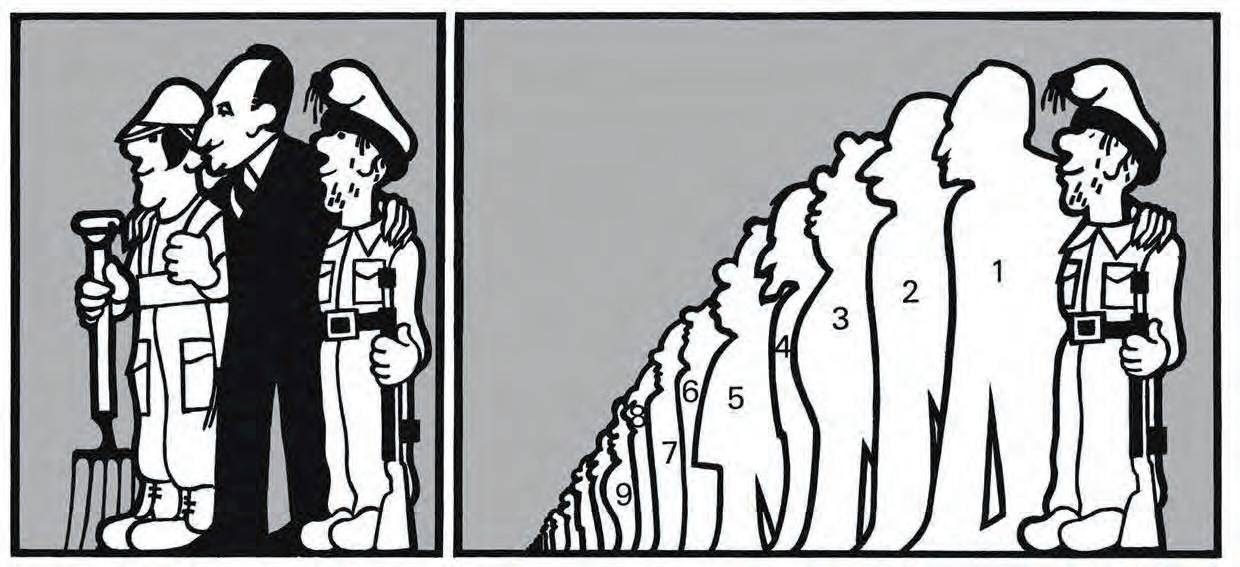
POVO, VASCO, ETC., ETC., MFA (D'APRÈS JOÃO ABEL MANTA) – 1975
O culto do líder Vasco Gonçalves, ladeado por um soldado e um camponês, uma das muitas ilustrações de João Abel Manta que marcaram os anos de 1974 e 1975, sempre glorificadoras do PCP e da estratégia política dos comunistas, aparece desconstruído no cartoon que a ladeia: face ao povo armado tudo o resto são figuras secundárias e anónimas
THE FOLK-VASCO-ETC., ETC.-MFA* (ACCORDING TO JOÃO ABEL MANTA**) – 1975
The cult of the leader Vasco Gonçalves***, flanked by a soldier and a peasant, one of the many illustrations by João Abel Manta that marked the years 1974 and 1975, always glorifying the PCP**** and the communists' political strategy, appears deconstructed in the cartoon: in the face of the armed people, everything else is secondary and anonymous figures
* T.N. – The MFA (Armed Forces Movement) was a military movement responsible for the 25 April 1974 Revolution in Portugal, which put an end to dictatorship ** T.N. – João Abel Manta is a Portuguese architect, painter, illustrator and cartoonist *** T.N. – Vasco Gonçalves was a communist Prime Minister **** T.N. – PCP is the acronym that stands for "Portuguese Communist Party"
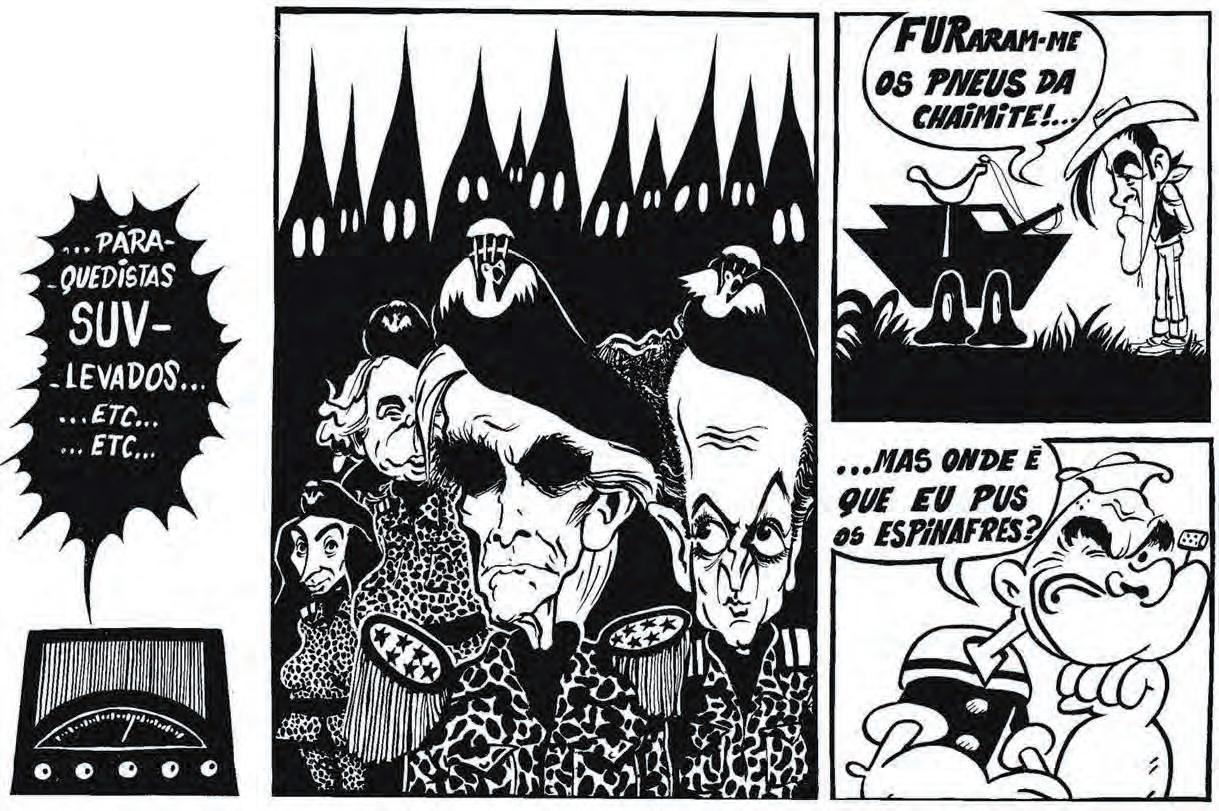

KAFARNAUM – 1975
Em pleno PREC no verão de 1975, o país vive em intrincada e acalorada balbúrdia política. Nesta espécie de aldeia bíblica de «Kafarnaum», nesta bagunça político-militar, as figuras e figurões confundem-se com famosas personagens da BD: Lucky Luke, Popeye, D. Quixote, misturam-se com o almirante Pinheiro de Azevedo, o major Dinis de Almeida ou o general Costa Gomes. E Cunhal surge como o grande mágico e manipulador Mandrake (as tiras de banda desenhada sob o nome «Kafarnaum» foram publicadas no Expresso ao longo de 100 números)
KAFARNAUM – 1975
In the summer of 1975, in the midst of PREC, the country is in an intricate and heated political turmoil. In this sort of biblical village of “Kafarnaum”, in this political-military mess, the figures and bigwigs are confused with famous comic book characters: Lucky Luke, Popeye, Don Quixote, are mixed up with Admiral Pinheiro de Azevedo, Major Dinis de Almeida or General Costa Gomes. And Cunhal* appears as Mandrake, the great magician and manipulator (the comic strips under the name “Kafarnaum” were published in Expresso newspaper over 100 print runs)
* T.N. – Álvaro Cunhal was the Secretary-General of the Portuguese Communist Party
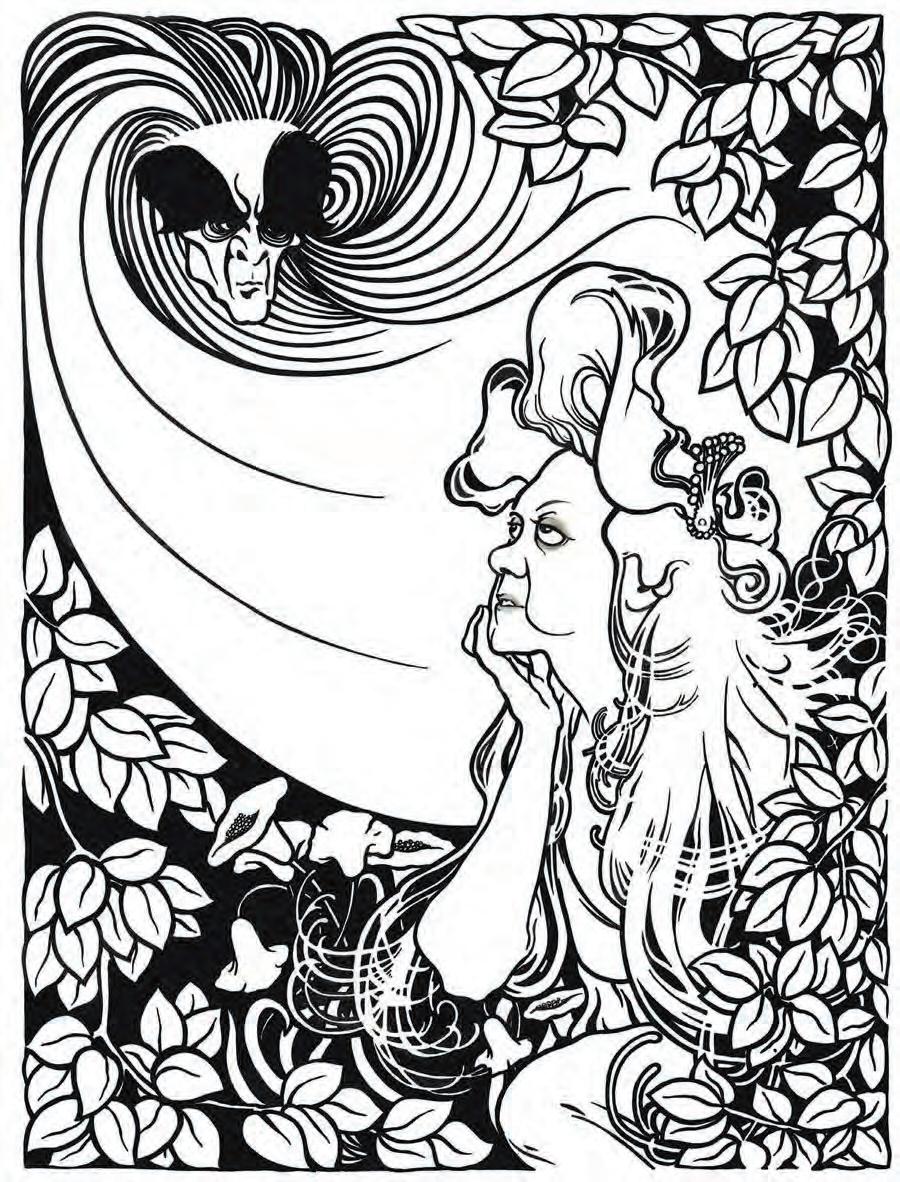
À ESPERA DO OUTONO QUENTE – 1975
Álvaro Cunhal, que dizia ver na União Soviética o Sol da Terra, e Mário Soares, que afirmava ter a Europa connosco, eram as duas faces do confronto político que incendiava o verão quente de 1975
AWAITING THE HOT AUTUMN – 1975
Álvaro Cunhal, who said he saw “the Earth’s Sun in the Soviet Union”, and Mário Soares, who claimed to have “Europe with us”, were the two sides of the political confrontation that ignited the hot summer of 1975
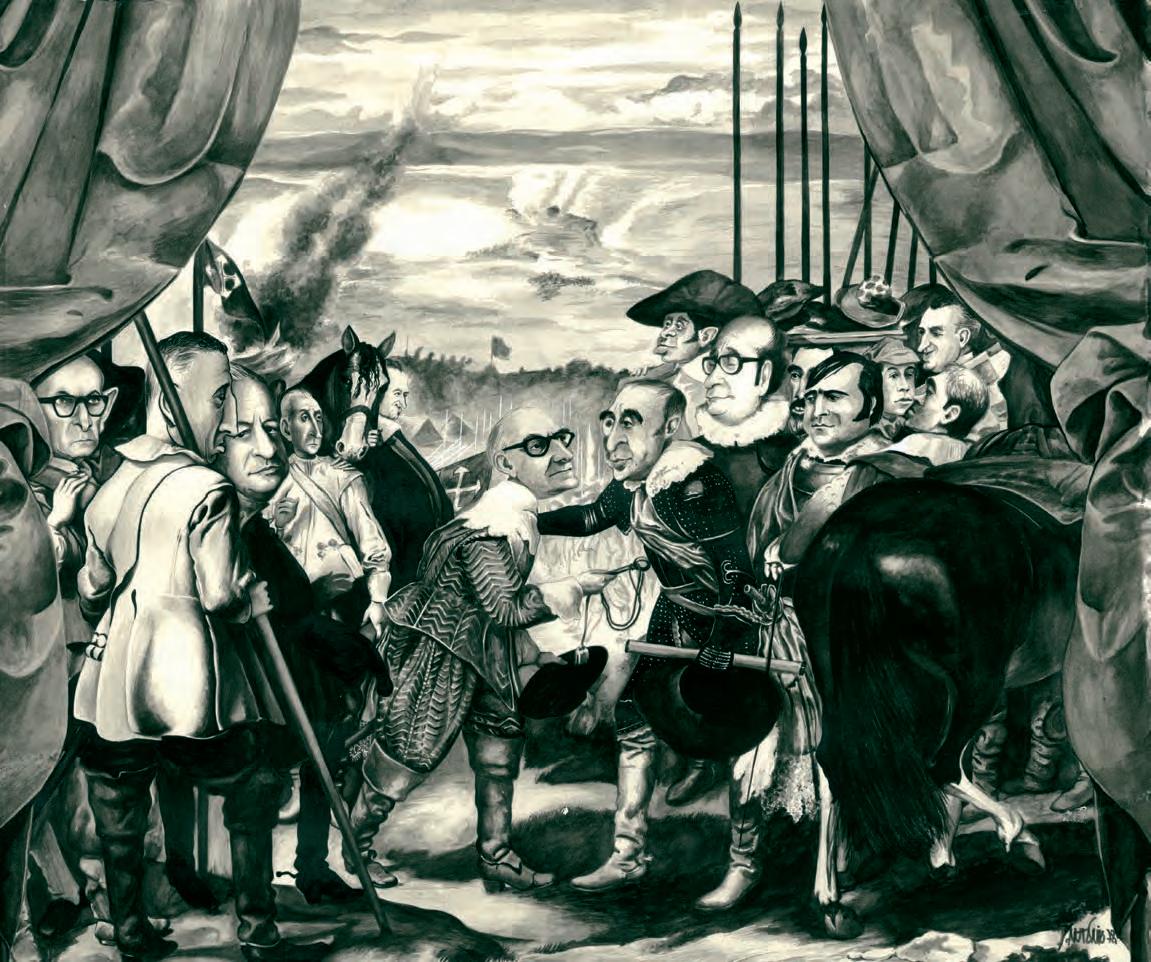
A RENDIÇÃO DO CARMO (D’APRÈS VELÁZQUEZ) – 1978
A queda da ditadura do Estado Novo no quartel do Carmo, quando Marcelo Caetano se rendeu a António de Spínola, vem recriar a célebre obra de Velázquez A Rendição de Breda (durante a guerra da Flandres, no século XVII). Caetano e Spínola estão no centro da ilustração, com os vencidos Américo Tomás, Silva Cunha, Moreira Baptista ou Salazar no lado de Caetano; e, no lado oposto, de Spínola, os vencedores Costa Gomes, Vasco Lourenço, Otelo ou Jaime Neves. De ambos os lados, com representação dupla, surge Veiga Simão
CARMO’S* SURRENDER (ACCORDING TO VELÁZQUEZ) – 1978
The fall of Estado Novo (New State) dictatorship in the Carmo barracks, when Marcelo Caetano surrendered to António de Spínola, recreates Velázquez’s famous work Breda’s Surrender (during the Flanders war in the 17th century). Caetano and Spínola are at the centre of the illustration, with the vanquished Américo Tomás, Silva Cunha, Moreira Baptista or Salazar**, on Caetano’s side; and, on Spínola’s opposite side, victors Costa Gomes, Vasco Lourenço, Otelo or Jaime Neves***. Veiga Simão**** appears on both sides, with double representation * T.N. – The Carmo Barracks were the focal point and main stage of the Revolution of 25 April 1974, where dictator Marcelo Caetano capitulated and the dictatorship fell. ** T.N. – All of them figures from the fascist regime *** T.N. – All of them figures linked to the 25th April Revolution **** T.N. – Veiga Simão was Minister of Education in both political regimes
SURFANDO – 1977
Criado em 1975 após o 11 de março pela Assembleia do MFA, o Conselho da Revolução (CR) integra os principais chefes militares e do MFA e funciona como uma tutela político-militar do poder civil, governo e Parlamento. Institucionalizado na Constituição de 1976, o CR (onde se destacam figuras mediáticas como Melo Antunes, Vasco Lourenço e Sousa e Castro) mantém o seu poder de intervenção até ser extinto na revisão constitucional de 1982
SURFING – 1977
Created in 1975 after 11 March* by the MFA Assembly, the Council of the Revolution (CR) includes the main military and MFA leaders and functions as a political-military guardian of civil power, Government and Parliament. Institutionalized in the 1976 Constitution, the CR (where media figures such as Melo Antunes, Vasco Lourenço and Sousa e Castro stand out) maintained its intervening power until it was abolished in the 1982 constitutional revision
* T.N. – Military Coup attempt by General Spínola
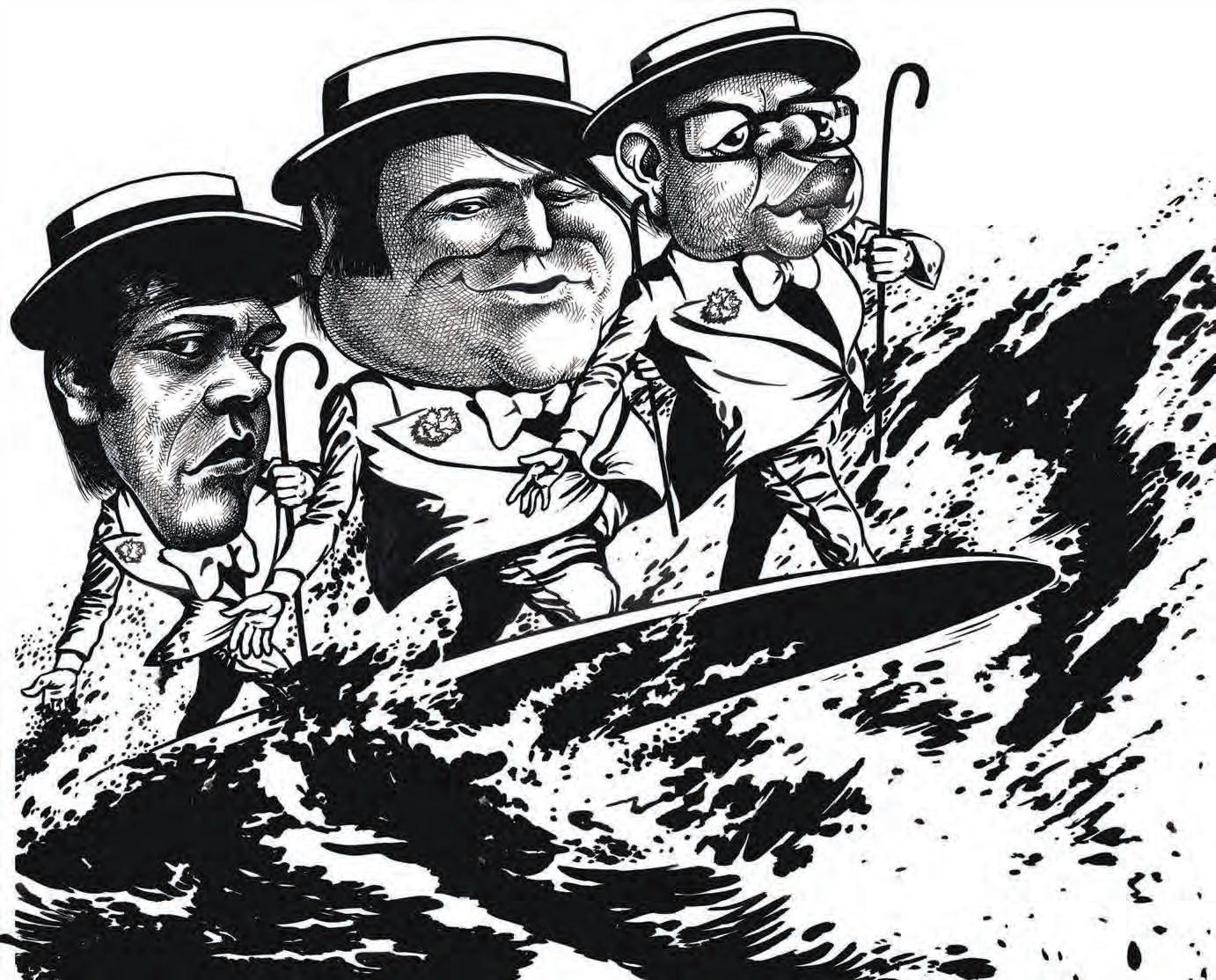

HOMO REVOLUCIONARIUS – 1980
Seis anos depois da revolução, alguns capitães de Abril mantêm intervenção na vida política do país — como Melo Antunes, Vítor Alves, Vasco Lourenço ou Otelo Saraiva de Carvalho —, mas já são vistos como homens das cavernas, figuras de um passado distante
HOMO REVOLUCIONARIUS – 1980
Six years after the revolution, some April’s captains are still involved in the country’s political life — such as Melo Antunes, Vítor Alves, Vasco Lourenço or Otelo Saraiva de Carvalho — but they are already seen as cavemen, figures from a distant past

A GAIOLA ABERTA – 1979
Maria de Lourdes Pintasilgo tomou posse como primeira-ministra a 1 de agosto de 1979, chefiando o último governo de iniciativa presidencial do general Eanes, com a incumbência de preparar a realização das legislativas de 2 de dezembro. Pintasilgo não se limita a uma governação de mera gestão corrente e aprova várias leis e medidas de cariz social. O que desagrada aos líderes da recém-constituída AD. Sá Carneiro e Freitas do Amaral querem meter «Pintasilgo na gaiola»
THE OPEN CAGE – 1979
Maria de Lourdes Pintasilgo took office as Prime Minister on August 1, 1979, heading General Eanes’ last presidential initiative government, with the task of preparing for the 2 December parliamentary elections. Pintasilgo did not limit herself to mere day-to-day governance and passed several laws and sociallyorientated measures, which displeased the leaders of the newly-constituted AD*. Sá Carneiro and Freitas do Amaral** want to put “Pintasilgo in the cage”***
* T.N. – AD is the acronym that stands for “Democratic Alliance”, a centre-left political alliance”
** T.N. – Sá Carneiro is the leader of the Social-Democrats and Freitas do Amaral is the leader of the Christian-Democrats *** T.N. – “Pintasilgo”, written with two “s” (pintassilgo) means goldfinch (a type of bird) in Portuguese. It was deemed as a word play aimed at saying that Prime Minister Pintasilgo (“pintassilgo”, the bird, should be limited in her powers — “put in a cage”
VENTRILOQUIA – 1979
Líder do PSD desde 1974, com intermitências (devido a doença e a dissensões internas no partido), Francisco Sá Carneiro recupera a liderança partidária em julho de 1978 e põe o partido a falar a uma só voz. Em 1979, forma uma coligação pré-eleitoral, a AD – Aliança Democrática, com o CDS, o PPM e os Reformadores. A 2 de dezembro, a AD vencerá as eleições legislativas com 45,3% e maioria absoluta no Parlamento
VENTRILOQUISM – 1979
Leader of the PPD/PSD (Social Democratic Party) since 1974, intermittently (due to illness and internal dissentions within the party), Francisco Sá Carneiro regained party leadership in July 1978 and got the party speaking as a single voice. In 1979, he formed a pre-election coalition, the AD – Aliança Democrática (Democratic Alliance), with the CDS (Christian Democratic Party), PPM (Monarchist Party) and Reformadores (Party situated in the political Centre). On December 2, AD won the parliamentary elections with 45.3% and an absolute majority in Parliament

A COROA E OS ESPINHOS – 1981
Ramalho Eanes acaba de ser reeleito Presidente em 7 de dezembro de 1980, com 56,4% dos votos. Mas contra os desejos da AD, de Sá Carneiro (que morrera três dias antes no desastre de Camarate) e também de Mário Soares. O Presidente entra em 1981 com menos apoios e mais espinhos partidários (Helena Roseta, Soares, Freitas, Balsemão, Ângelo Correia, etc.) na sua coroa de Belém
THE CROWN AND THE THORNS – 1981
Ramalho Eanes had just been re-elected President on 7 December 1980, with 56.4% of the total votes, but against the wishes of Sá Carneiro’s AD (who had died three days earlier in the Camarate accident) and also of Mário Soares. The President entered 1981 with less support and more parties’ “thorns” (Helena Roseta, Soares, Freitas, Balsemão, Ângelo Correia, etc.) on his Belém crown
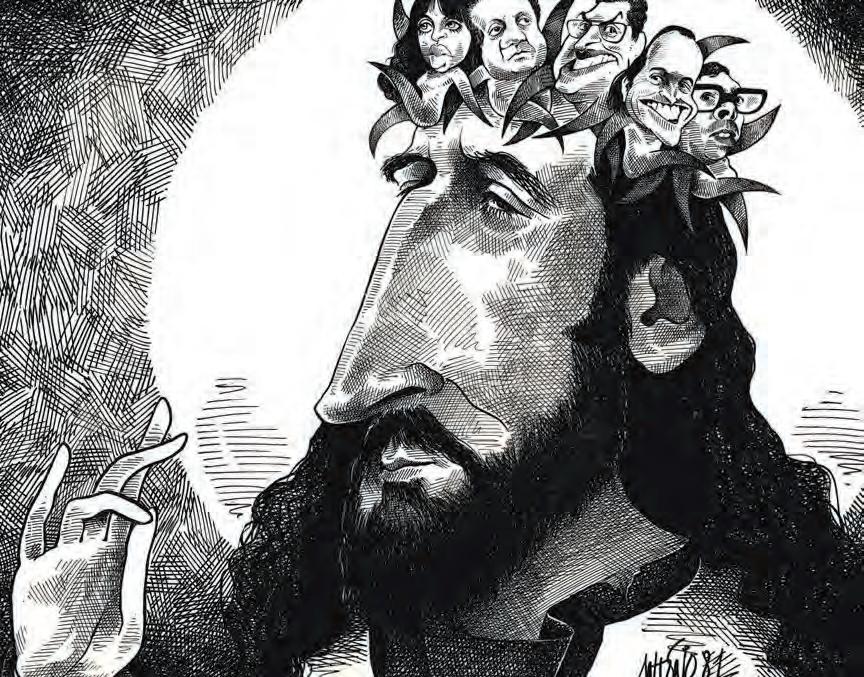
CRUZADISMO – 1985
Ao entrar em 1985, no último ano do seu último mandato presidencial, Ramalho Eanes tem pela frente várias encruzilhadas: o fim do Governo do Bloco Central provocado pelo novo líder do PSD, Cavaco Silva, a marcação de eleições já com a participação do PRD, o partido feito à sua imagem, a preparação da entrada do país na CEE e a expectativa de saber quem lhe iria suceder no Palácio de Belém
CROSSWORDS/CROSSROADS – 1985
Entering 1985, in the final year of his last presidential term, Ramalho Eanes faced several crossroads: the end of the Central Bloc Government* caused by the new PSD leader, Cavaco Silva, the scheduling of elections already with the participation of the PRD, the party built around his image, the preparation for the country’s entry into the EEC and the expectation of knowing who would succeed him at the Belém Palace
* T.N. – Central Bloc is the name given to the coalition of Socialists and Social-Democrats
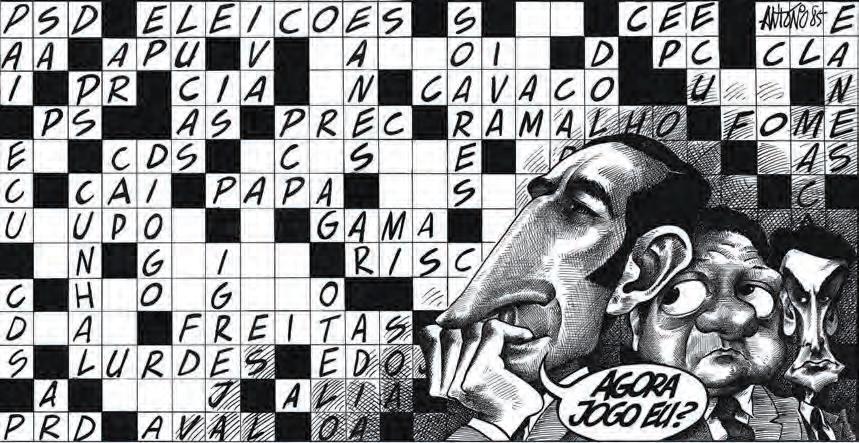

JOGOS OLÍMPICOS – 1980
Os Jogos Olímpicos de 1980, em Moscovo, decorrem sob o boicote de dezenas de países ocidentais, devido à invasão soviética do Afeganistão. E o PCP de Cunhal, sempre alinhado com a política da URSS e a ortodoxia do PCUS de Brejnev, contrasta com os outros partidos comunistas ocidentais, o PCI de Berlinguer, o PCF de Marchais ou o PCE de Carrillo. Se os eurocomunistas fazem os mínimos, o PCP, o mais fiel dos fiéis a Moscovo, faz obviamente os máximos
OLYMPIC GAMES – 1980
The 1980 Olympic Games in Moscow were held under the boycott of dozens of Western countries due to the Soviet invasion of Afghanistan. And Cunhal’s PCP, always aligned with the policy of the USSR and the orthodoxy of Brezhnev’s CPSU, contrasts with the other Western communist parties, Berlinguer’s PCI, Marchais’ PCF or Carrillo’s PCE. If the Eurocommunists are doing the minimum, the PCP, the most faithful of those loyal to Moscow, is obviously doing its maximum

VINTE E CINCO DE ABRIL – 1981
O filme do 25 de Abril revisitado no seu 7.0 aniversário. De como as Forças Armadas, sustentáculo do Estado Novo e intervenientes em três guerras coloniais em África, se converteram no instrumento de conquista da liberdade e da democracia
TWENTY FIFTH APRIL – 1981
The 25th April film revisited on its 7th anniversary. How the Armed Forces, the mainstay of the Estado Novo (Fascist New State regime) and interveners in three colonial wars in Africa, became the instrument for the conquest of freedom and democracy
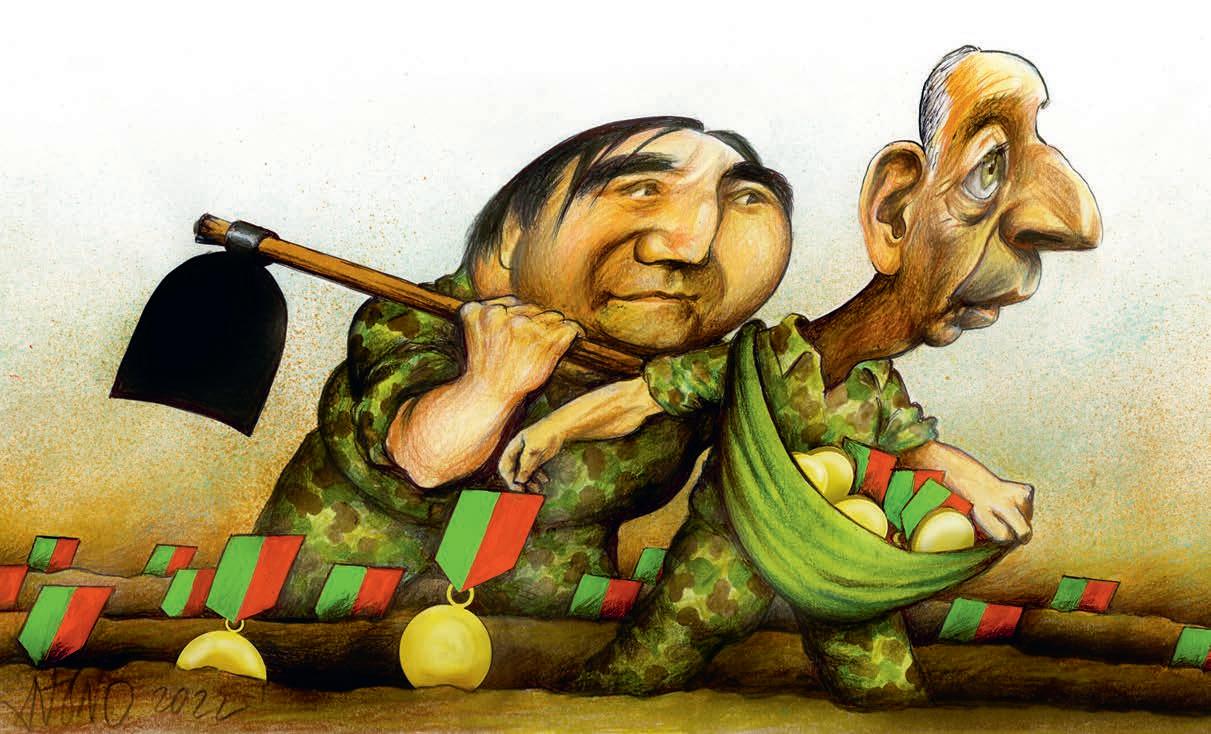
O SEMEADOR DE MEDALHAS – 2022
Em fevereiro e março de 2022, dando início às comemorações dos 50 anos do 25 de Abril, o Presidente Marcelo condecora com a Ordem da Liberdade 30 oficiais de Abril, militares que participaram na preparação ou execução do golpe de 25 de Abril. A ideia do Presidente é «fazer justiça, que há muito já devia ter sido feita» aos militares que deram a liberdade e a democracia aos portugueses. Já em 2021, o PR havia medalhado cerca de 30 oficiais de Abril. E a intenção é condecorar 120 oficiais até 2024, de uma lista que está a ser elaborada por Vasco Lourenço, presidente da Associação 25 de Abril
THE MEDAL SOWER – 2022
In February and March 2022, at the start of the preparation for the celebrations of the 50th anniversary of the 25th April, President Marcelo awarded the Order of Liberty to 30 military officers who took part in the preparation or execution of the 25th April coup. The President’s idea was "to do justice, which is long overdue” to the military officers who gave freedom and democracy to the Portuguese. In 2021, the President had already awarded medals to around 30 April officers. And the intention was to award 120 officers by 2024, from a list that is being drawn up by Vasco Lourenço, president of the 25th April Association

OS PÁSSAROS – 2022
No dia 29 de junho, o fogoso e impulsivo ministro das Infraestruturas, Pedro Nuno Santos, fez publicar um despacho do seu Ministério no qual se decidia que o futuro aeroporto de Lisboa seria no Montijo (transitoriamente) e Alcochete. Na manhã do dia seguinte, o primeiro-ministro publicou a revogação desse despacho. António Costa, que na véspera estava em Madrid e disse desconhecer tal despacho, invocou a unidade e colegialidade do governo, que o ministro ignorara, necessária a estas decisões, bem como a necessidade de consenso nesta matéria com o líder do PSD, que acabava de ser eleito, e com o PR. Quando se esperava que Pedro Nuno Santos apresentasse a demissão, o ministro apareceu de corda ao pescoço, numa comunicação pública, a pedir desculpa
THE BIRDS – 2022
On June 29, the fiery and impulsive Minister of Infrastructure, Pedro Nuno Santos, published an order from his Ministry in which it was decided that Lisbon’s future airport would be in Montijo (temporarily) and Alcochete. On the morning of the following day, the Prime Minister published the revocation of this order. António Costa, who had been in Madrid the day before and said he was unaware of the order, invoked the necessary unity and collegiality of the government for these decisions, which the minister had ignored, as well as the need for consensus on this issue with the PSD leader, who had just been elected, and the Prime Minister. Just when Pedro Nuno Santos was expected to resign, the minister came out as if with a rope round his neck, apologizing in a public statement
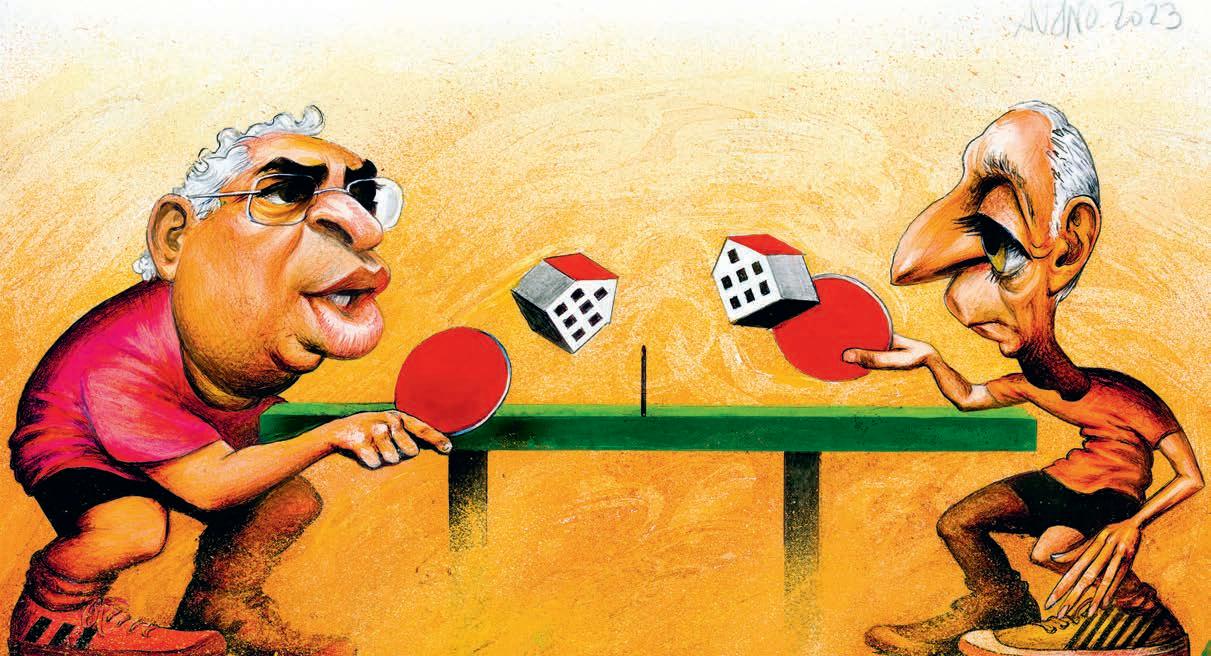
MOVIMENTOS CRUZADOS – 2023
Em fevereiro de 2023, o Governo de António Costa anuncia o pacote legislativo Mais Habitação, que introduz grandes alterações no setor, desde o arrendamento forçado de imóveis devolutos às restrições ao alojamento local. A proposta é alvo de muitas críticas, incluindo do Presidente da República, mas em julho a maioria absoluta do PS aprova, sem outros apoios, o decreto no Parlamento. No final de agosto, o Presidente Marcelo veta o diploma e devolve-o à AR, justificando que «não é credível» nem obteve «o consenso mínimo». Em setembro, o PS reaprova na AR, sem qualquer alteração, o pacote de leis, o que obriga o PR a promulgá-lo mesmo discordando. É o que Marcelo faz no dia seguinte, deixando um aviso: «Espero que corra bem»
CROSS MOVEMENTS – 2023
In February 2023, António Costa’s government announces the Mais Habitação (More Housing) legislative package, which introduces major changes to the sector, from the forced rental of vacant properties to restrictions on local accommodation. The proposal receives a lot of criticism, including from the State President, but in July the PS absolute majority approves the decree in Parliament without any other support. At the end of August, President Marcelo vetoed the decree and sent it back to Parliament, saying it was “not credible” and had not obtained “the minimum consensus”. In September, the PS reapproves the package of laws in the Parliament without any changes, which forces the President to promulgate it even if he disagrees with it. This is what Marcelo does the next day, leaving a warning: “I hope it runs well”
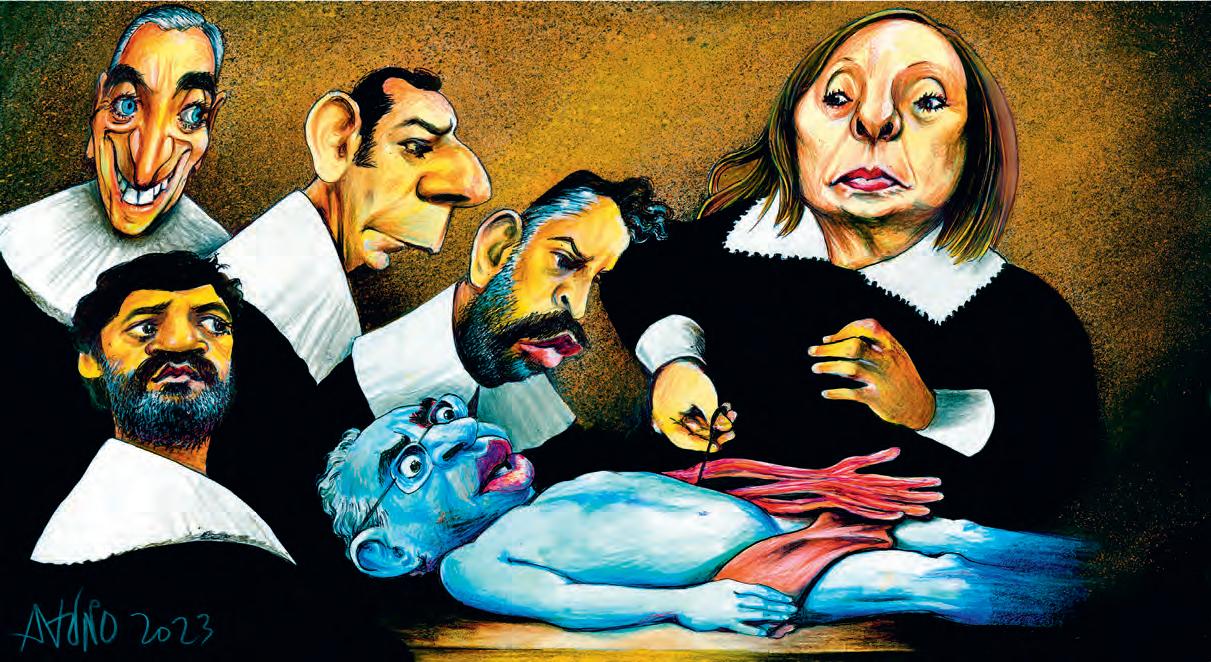
A LIÇÃO DE ANATOMIA (D'APRÈS REMBRANDT) – 2023
Na manhã de 7 de novembro, o Ministério Público leva a cabo 42 buscas, no âmbito da Operação Influencer, incluindo à residência oficial do primeiro-ministro em São Bento e aos ministérios das Infraestruturas e do Ambiente. O processo envolve os crimes de corrupção, prevaricação e tráfico de influência e dois dos principais arguidos são muito próximos de António Costa: Lacerda Machado, conhecido como o seu «melhor amigo», e Vítor Escária, chefe de Gabinete de Costa (em cuja sala de trabalho são descobertos 75.800 euros em notas, escondidos entre livros e gavetas). À hora de almoço, o último parágrafo de um comunicado da PGR sobre a Operação refere que o primeiro-ministro também é suspeito e está a ser investigado. António Costa apresenta de imediato a demissão em Belém e o Presidente anuncia eleições antecipadas para 10 de março. Como no quadro de Rembrandt, A Lição de Anatomia (1632), o inesperado cadáver governativo de Costa é dissecado pela PGR Lucília Gago, sob o olhar atento de Ventura, Montenegro e Pedro Nuno Santos e a curiosidade divertida de Marcelo
THE ANATOMY LESSON (ACCORDING TO REMBRANDT) – 2023
On the morning of 7 November, the Public Prosecutor’s Office carried out 42 searches as part of the Influencer Operation, including in the Prime Minister’s official residence in São Bento and in the Ministries of Infrastructure and Environment. The process involves the crimes of corruption, malfeasance and influence peddling and two of the main defendants are very close to António Costa: Lacerda Machado, known as his “best friend”, and Vítor Escária, Costa’s chief of staff (in whose office 75,800 euros in notes were found out, hidden among books and drawers). At lunchtime, the last paragraph of a statement issued by the PGR on the Operation states that the Prime Minister is also a suspect and is being investigated. António Costa immediately submits his resignation in Belém and the President announces early elections for 10 March. As in Rembrandt’s painting The Anatomy Lesson (1632), Costa’s unexpected government corpse is dissected by PGR (State Attorney-General) Lucília Gago, under the watchful eye of Ventura, Montenegro and Pedro Nuno Santos and the amused curiosity of Marcelo

Ó TEMPO VOLTA P'RA TRÁ S... – 2024
O PSD de Luís Montenegro decide federar uma frente eleitoral de centro-direita para as legislativas de 10 de março, por forma a potenciar o número de eleitos e a contrariar o crescimento do Chega. Face à recusa da IL, o PSD faz renascer a sigla AD, a Aliança Democrática de Sá Carneiro em 1979, numa coligação com o CDS de Nuno Melo, que perdera todos os seus cinco deputados nas legislativas de 2022. Deixado de fora, o PPM agora liderado pelo fadista Gonçalo da Câmara Pereira, que reduziu o partido a uns invisíveis 260 votos em 2022, protesta, ameaça com queixa no TC e, no início de janeiro, acaba por ser também integrado na AD. Com o fadista do PPM, conhecido marialva e desbocado a roçar a boçalidade, a AD parece mesmo um regresso ao passado
OH TIME, PLEASE TURN BACK... – 2024
Luís Montenegro’s PSD decided to federate a centre-right electoral front for the 10 March parliamentary elections, in order to boost the number of elected representatives and to reverse the growth of Chega. Faced with IL’s refusal, PSD revived the acronym AD, the Democratic Alliance of Sá Carneiro in 1979, in a coalition with Nuno Melo’s CDS, which had lost all five of its MPs in the 2022 parliamentary elections. Left out, the PPM now led by the fado singer Gonçalo da Câmara Pereira, who reduced the party to invisible 260 votes in 2022, protested and threatened to file a complaint with the TC (Constitutional Court) and, at the beginning of January, ended up being integrated into the AD as well. With the PPM’s fado singer, known as a marialva* and an outspoken man bordering boorishness, the AD really does look like a return to the past
* T.N. – A “marialva” is a male chauvinist, macho, sexist and misogynistic, who tends to see women as mere objects of conquest, something to “use and throw away” and is usually linked to bullfighting environment
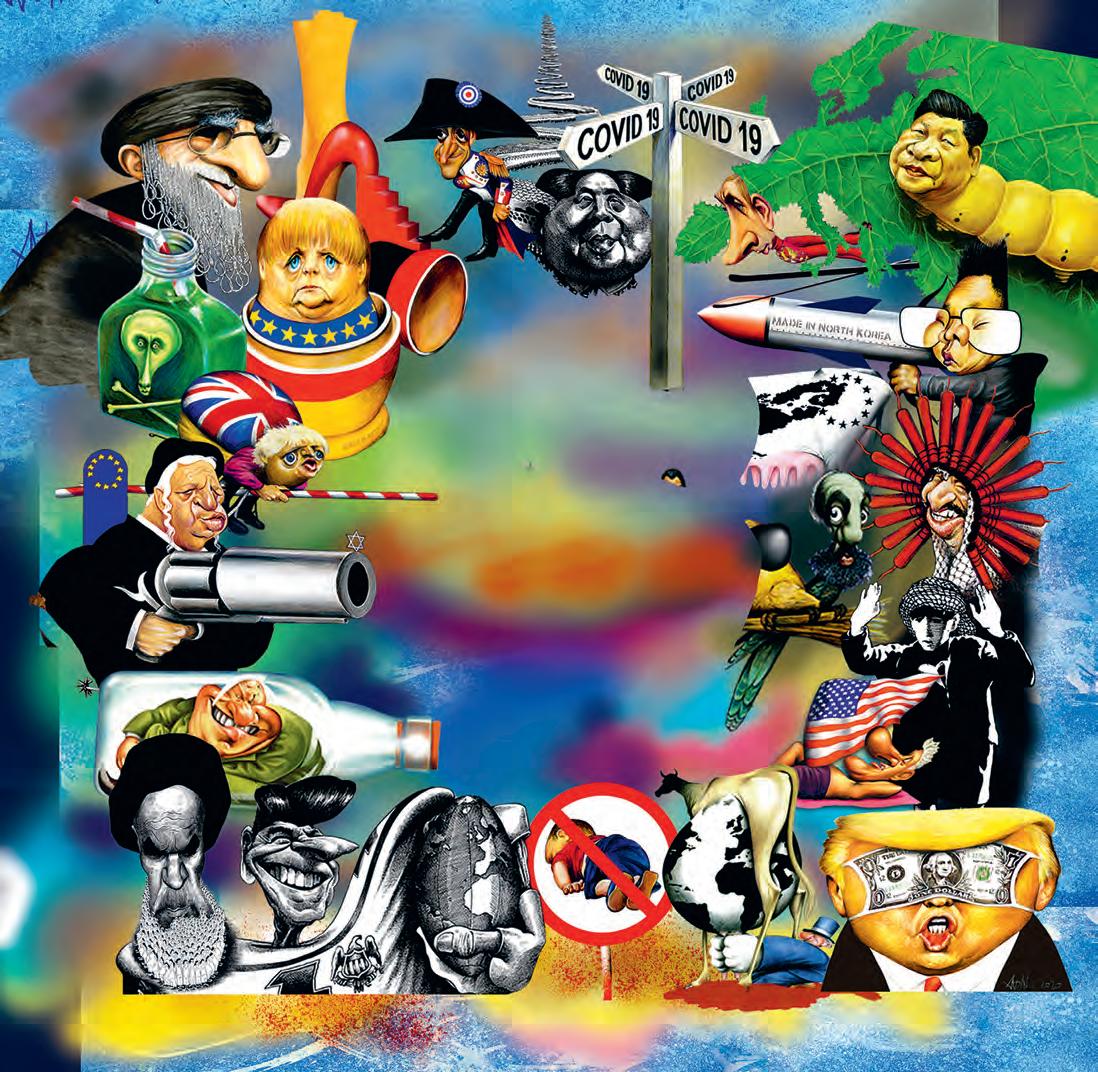
Rir para não chorar
Tomo como exemplo o cartoon Pesadelo iraniano, de 2023, que num primeiro olhar é apenas uma caricatura do Ayatollah Ali Khamenei. Mas, olhando melhor, as suas barbas brancas revelam-se forcas, imagem aterradora, quando sabemos que na altura o regime fundamentalista estava a enforcar centenas de pessoas que apenas pediam liberdade (sobretudo para as mulheres). António fez aqui, aliás, uma variação sobre um tema recorrente, já que em 1979 caricaturou o líder espiritual da infeliz revolução islâmica iraniana, o Ayatollah Khomeini, com a sua pilosidade facial substituída por prisioneiros de olhos vendados na iminência do seu fuzilamento (As barbas de Khomeini ), invocando o modo como então eram tratados no Irão os opositores, suspeitos ou reais.
Perante a tragédia, o autor faz-nos sorrir. Mas presumo que nem a ele nem a nós, observadores do seu trabalho, pesa a consciência. O riso e a dor fazem parte da condição humana e andam quase sempre de mãos dadas. Ridendo castigat mores («corrige os costumes sorrindo»), gravaram os latinos em palavras escritas na pedra. Que é como quem diz: se se trata de melhorar o mundo, mais vale fazê-lo de sorriso nos lábios.
E eu vejo a criatividade de António como uma forma particular de denunciar os males do mundo no sentido de o melhorar. Se o faz provocando sorrisos, não importa, desde que a mensagem chegue aos destinatários. E sem dúvida que estamos perante um método de grande eficácia e inteligência para dar conta de injustiças, opressões e desequilíbrios, porque ninguém consegue ficar indiferente a estas imagens — e depois do riso é inevitável vir também a reflexão. É que os cartoons de António, que dispensam palavras e são de rápida apreensão, põem-nos a pensar. E a pensar de modo crítico, que é o mais importante.
To laugh so as not to cry
I take as an example the cartoon Iranian nightmare, from 2023, which at first glance is just a caricature of Ayatollah Ali Khamenei. But looking more attentively, his white beard turns out to be a noose, a terrifying image when we know that at the time the fundamentalist regime was hanging hundreds of people who were simply asking for freedom (especially for women). In fact, António did a variation on a recurring theme here, since in 1979 he caricatured the spiritual leader of Iran’s unfortunate Islamic revolution, Ayatollah Khomeini, with his facial hair replaced by blindfolded prisoners on the verge of being shot (Khomeini's beards), invoking the way opponents, suspected or real, were treated in Iran at the time.

Com efeito, se uma imagem vale por mil palavras, um cartoon de António vale por um ensaio inteiro. Quanto é que seria preciso escrever para explicar as situações que ele ilustra e sintetiza exemplarmente nas caricaturas dos ayatollahs — ou em muitos outros desenhos que aqui se publicam? Com uma vantagem acrescida: haverá sempre muito mais gente a olhar para os cartoons dele do que a ler os tais ensaios.
Tributário do grande David Levine (como se percebe no cartoon inicial desta secção, sobre Menachem Begin), António cedo desenvolveu o seu próprio estilo e a sua estética, fundando uma escola que é só dele e se conserva gloriosa no último meio século. Junta com brilho duas disciplinas do humor ilustrado: a caricatura e o cartoon propriamente dito. É claro que nem todos os seus trabalhos são denúncias: por vezes apenas retrata pessoas (a caricatura de Gorbachev com o mapa-múndi a confundir-se com as manchas na testa, de 1985, tornou-se clássica) ou situações (com A vaca da economia, de 1992, também usando o globo terrestre), mas sempre através
In the face of tragedy, the author makes us smile. But I assume that neither he nor we, the observers of his work, are weighed down by conscience. Laughter and pain are part of the human condition and almost always go hand in hand. Latins engraved in stone the written words “Ridendo castigat mores” (“Correct customs by laughing”), what is to say: if the purpose is to improve the world, you might better do it with a smile on your lips.
And I see António’s creativity as a particular way of denouncing the evils of the world in order to make it better. It doesn’t matter if he does it by causing smiles, as long as the message gets through and reaches its addressees. And there’s no doubt that this is a highly effective and intelligent method to report injustices, oppression and imbalances, because no one can remain unresponsive to these images — and after laughter, reflection is also inevitable. The fact is that António’s cartoons, which need no words and are quick to grasp, make us think. And to think in a critical manner, which is the most important thing.
Actually, if a picture is worth a thousand words, a cartoon by António is worth an entire essay. How much would need to be written to explain the situations he illustrates and summarizes so well in his caricatures of the ayatollahs — or in the many other drawings published here? With an added advantage: there will always be many more people looking at his cartoons than reading such essays.
A tributary of the great David Levine (as can be understood in the opening cartoon of this section, about Menachem Begin), António developed his own style and his aesthetic at an early stage, founding a school that is exclusively of his own and has remained glorious for the last half century. He brilliantly brings together two disciplines of illustrated humour: caricature and cartooning itself. It is clear that not all of his works are denunciations: sometimes he just portrays people (the 1985 caricature of Gorbachev with the world map blending in with the spots on his forehead has become a classic) or situations (with The cow of the economy from 1992, also using the world globe), but always through the hyperbole (indispensable in his role) and without ever sparing his talent. With enormous verve and total independence (having known him for decades, I never knew how he has voted in elections), he always fulfilled one of the most sacred
da hipérbole (indispensável no seu múnus) e sem nunca se poupar no talento. Com enorme verve e total independência (conhecendo-o há décadas, nunca soube como votou em eleições), sempre cumpriu uma das funções mais sagradas do cartoonismo: ser incómodo (coisa que alguns dos que por ele são visados confundem com ser desagradável, mas que nada tem que ver).
António já teve amargos de boca por causa do politicamente correto e da nova cultura do cancelamento, mas estou em crer que, para ele, isso são medalhas, porque percebeu ter atingido o objetivo, ao tocar num qualquer nervo. A sua ilustração O gueto de Varsóvia em Chatila, de 1982, evocando uma célebre fotografia relacionada com o Holocausto, onde, por respeito às vítimas de inomináveis perseguições e atentados aos direitos humanos, fossem judaicas ou palestinianas, só aplicou a caricatura a militares israelitas, causou a António não poucos dissabores, apesar de ter sido distinguida com o Grande Prémio do Salon International de Cartoon de Montréal, à época o mais importante certame em todo o mundo relacionado com a atividade. E afinal o que veio a passar-se na Faixa de Gaza em 2023/2024 (não desculpável por ter sido antecedido de um hediondo massacre perpetrado em Israel) veio demonstrar a presciência de António no tratamento de tão delicado assunto.
Trata-se, para o cartoonista, de andar sobre brasas. Ainda acerca da mesma temática, a edição digital internacional do New York Times publicou em 2019 o cartoon de António Pax canina e depois apagou-o, embaraçados que ficaram os seus editores pela controvérsia à volta de um Netanyahu surgido como cão-guia, de estrela de David ao pescoço, a guiar um Trump cego (ou a não querer ver, que, como se sabe, é o pior dos cegos). Ao que parece, terá sido sacrilégio misturar o símbolo da religião judaica com a balbúrdia política do Médio Oriente. Mas não é o eterno conflito que nessa região se desenrola um produto, em larga medida, do confronto de dogmas religiosos?
functions of cartooning: to be a nuisance (something that some of those he targets confuse with being unpleasant, but which has nothing to do with it).
António has had his share of bitter reactions to political correctness and the new culture of cancellation, but I believe that these mean medals for him, because he realised that he had achieved his goal by hitting a nerve. His illustration The Warsaw ghetto in Shatila from 1982, evoking a famous photograph related to the Holocaust, where, out of respect for the victims of unspeakable persecution and attacks on human rights, whether Jewish or Palestinian, he only applied the caricature to Israeli soldiers, caused António considerable dissatisfaction, despite having been awarded the Grand Prize at the Salon International de Cartoon de Montréal (Montreal International Cartoon Exhibition), at the time the most important event in the world related to this activity. And after all, what has happened in the Gaza Strip in 2023/2024 (not excusable because it was preceded by a heinous massacre perpetrated in Israel) ended up demonstrating António’s prescience in dealing with such a delicate subject.

For the cartoonist, it’s about walking on hot coals. Still on the same topic, the international digital edition of the New York Times published António’s Pax canina (Doggy Peace) cartoon in 2019 and then deleted it, as its editors were embarrassed by the controversy surrounding Netanyahu appearing as a guide dog, with a Star of David around his neck, guiding a blind Trump (or not wanting to see, which, as we know, is the worst kind of blindness). Apparently, it was a sacrilege to mix the symbol of the Jewish religion with the political turmoil of the Middle East. But isn’t the eternal conflict that is taking place in this region largely the product of the clash of religious dogmas?
Acima de tudo, em defesa da liberdade de expressão, é fundamental que deixem António continuar a ser António, irónico, sarcástico, mordaz e certeiro porque excessivo. Todos ficamos a ganhar.
Above all, in defence of freedom of expression, it is essential to let António continue to be António, ironic, sarcastic, scathing and sharp because he is excessive. We all stand to win.
JOAQUIM VIEIRA Jornalista / Jornalist
1974-1984
DE CARTER A REAGAN NOS EUA, DE BREJNEV A ANDROPOV NA URSS, DO XÁ A KHOMEINI NO IRÃO E ACORDO DE PAZ ENTRE O EGITO E ISRAEL FROM CARTER TO REAGAN IN THE USA, FROM BREZHNEV TO ANDROPOV IN THE USSR, FROM THE SHAH TO KHOMEINI IN IRAN AND THE PEACE AGREEMENT BETWEEN EGYPT AND ISRAEL
MENACHEM BEGIN – 1977
Menachem Begin, primeiro-ministro (1977-83), consegue um acordo de paz e o reconhecimento de Israel pelo Egito do Presidente Sadat, em troca da devolução aos egípcios da península do Sinai
MENACHEM BEGIN – 1977
Menachem Begin, Prime Minister (1977-83), achieves a peace agreement and the recognition of Israel by President Sadat’s Egypt, in exchange for the return of the Sinai Peninsula to the Egyptians

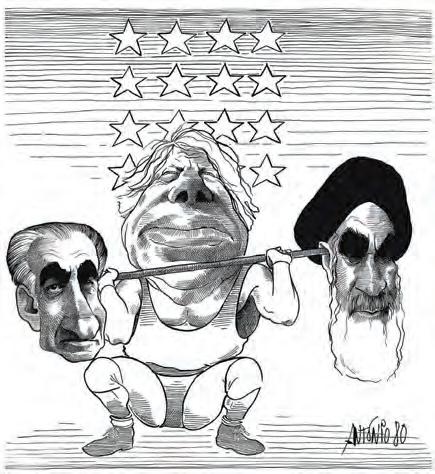
HALTEROFILISMO IRANIANO – 1980
O Presidente Carter dos EUA tenta resistir às pesadas heranças da revolução islâmica de 1979 no Irão, liderada pelo Ayatollah Khomeini, que depôs o Xá Reza Pahlavi
IRANIAN WEIGHTLIFTING – 1980
USA President Carter tries to resist the heavy legacies of the 1979 Islamic revolution in Iran, led by Ayatollah Khomeini, which ousted Shah Reza Pahlavi
LAVORES SOVIÉTICOS – 1978
Leonid Brejnev, líder da URSS (1964-82) e símbolo da Guerra Fria, tece a arame farpado a Alemanha de Leste
SOVIET SEWING WORKS – 1978
Leonid Brezhnev, leader of the USSR (1964-82) and symbol of the Cold War, weaves East Germany with barbed wire

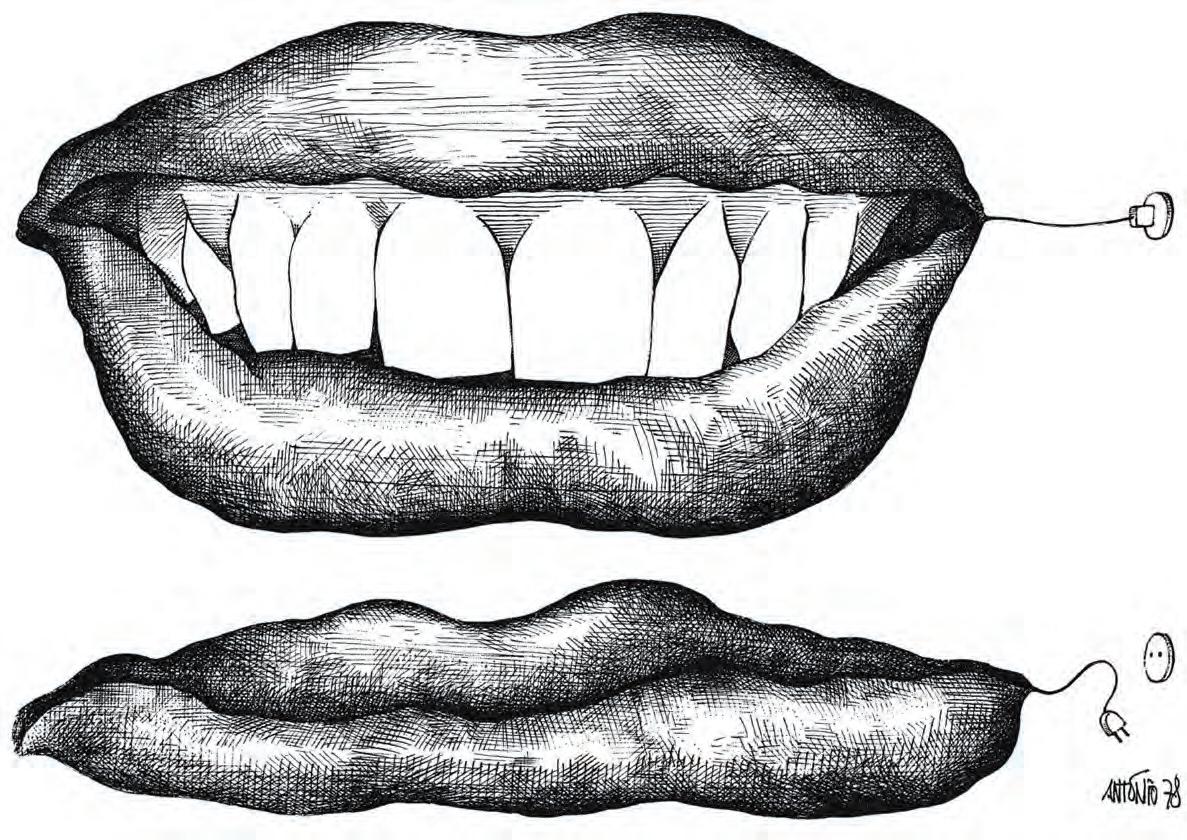
O SORRISO DE CARTER – 1978
O democrata James (Jimmy) Carter, 39.0 presidente dos EUA (1977-81), sucede a Gerald Ford. O magnata das plantações de amendoins na Geórgia vê a crise energética de 1978/79 estragar-lhe os bons resultados da economia, que entra em estagnação, e esvaziar-lhe o sorriso otimista, sua imagem de marca
CARTER’S SMILE – 1978
Democrat James (Jimmy) Carter, 39th. President of the USA (1977-81), succeeds Gerald Ford. The peanut plantation magnate from Georgia sees the 1978/79 energy crisis ruin his good results concerning economy, going into a period of stagnation and his optimistic smile, his trademark image, fades away
AS BARBAS DE KHOMEINI – 1979
Logo após a revolução de fevereiro de 1979, o fundamentalismo islâmico impõe-se no Irão, com a liderança religiosa e política dos ayatollahs xiitas a eliminar em fuzilamentos sumários todo e qualquer opositor
KHOMEINI'S BEARD – 1979
Immediately after the February 1979 revolution, Islamic fundamentalism imposes itself in Iran, with the religious and political leadership of the Shiite Ayatollahs eliminating any and all opponents by summary firing squad shootings

REAGAN – 1981
Aos 79 anos, Ronald Reagan, ex-ator de filmes de série B de Hollywood e ex-governador da Califórnia, toma posse como 40.0 presidente dos EUA (1981-1989)
REAGAN – 1981
At the age of 79, Ronald Reagan, former Hollywood B-series movie actor and former governor of California, is sworn in as the 40th. President of the United States. (1981-1989)


VODUÍSMO-ESTALINISMO – 1981
Na Polónia, um dos Estados-satélite da URSS, a crescente contestação e apoios do movimento sindical Solidarnosc, liderado pelo eletricista Lech Walesa, em defesa de mais liberdade e direitos dos trabalhadores, tornam-se uma ameaça e um pesadelo para Brejnev e os líderes soviéticos
VOODOOISM-STALINISM – 1981
In Poland, one of USSR’s satellite states, the growing protest and support for the Solidarnosc trade union movement, led by electrician Lech Walesa in defense of greater freedom and workers’ rights, became a threat and a nightmare for Brezhnev and the Soviet leaders
O CARREGADOR DE GAIOLAS – 1982
Fundado em 1980 nos estaleiros navais de Gdansk, o Solidarnosc amplia muito a sua militância e influência social, acabando por ser ilegalizado em 1982 e presos os seus dirigentes, incluindo Lech Walesa
THE CAGE CARRIER – 1982
Founded in 1980 in the shipyards of Gdansk, Solidarnosc greatly expands its militancy and social influence, ending up being illegalised and its leaders imprisoned, including Lech Walesa, in 1982


JARUZELSKI – 1984
O general Jaruzelski assume a liderança da Polónia e inicia em 1981 a repressão do movimento Solidarnosc. Impõe a lei marcial e, até à abertura política de Gorbachev em 1985, prosseguirá a perseguição à oposição sindical e aos meios católicos
JARUZELSKI – 1984
General Jaruzelski takes over the leadership of Poland and starts repressing the Solidarnosc movement in 1981. He imposes martial law and, until Gorbachev’s political opening in 1985, would continue to persecute the trade union opposition and Catholic circles

A EQUAÇÃO – 1981
Da esquerda para a direita e de cima para baixo. 1.a fila: Brejnev/Walesa, Papa João Paulo II e Jaruzelski/ Che Guevara, Fidel e Indira Gandhi/Marchais, Berlinguer e Santiago Carrillo (os eurocomunistas); 2.a fila: Khomeini, Kadhafi e Idi Amin/Shell e BP/Deng Xiaoping e Mao/Whisky White Horse e os cowboys Reagan e John Wayne/Thatcher, Schmidt e Mitterrand; 3.a fila: Renault, Ford, Volkswagen e Datsun/Moshe Dayan e Sadat, Sadat e Moshe Dayan, Arafat e Begin/A. Haig, Kissinger e Pinochet
THE EQUATION – 1981
From left to right and from top to bottom. 1st. row: Brezhnev/Walesa, Pope John Paul II and Jaruzelski/Che Guevara, Fidel and Indira Gandhi/ Marchais, Berlinguer and Santiago Carrillo (the Eurocommunists). 2nd. row: Khomeini, Gaddafi and Idi Amin/Shell and BP/Deng Xiaoping and Mao/Whisky White Horse and the cowboys Reagan and John Wayne/Thatcher, Schmidt and Mitterrand. 3rd. row: Renault, Ford, Volkswagen and Datsun/ Moshe Dayan and Sadat, Sadat and Moshe Dayan, Arafat and Begin/A. Haig, Kissinger and Pinochet

ANDROPOV – 1983
Yuri Andropov assume a liderança da URSS após a morte de Brejnev em 1982. Chega com a aura de modernizador tecnológico do regime, depois de 15 anos como chefe do KGB. Morre ao fim de ano e meio, no início de 1984
ANDROPOV – 1983
Yuri Andropov took over the leadership of the USSR after Brezhnev’s death in 1982. He arrived with the aura of a regime’s technological moderniser, after 15 years as head of the KGB. He died after a year and a half, at the beginning of 1984
ARAFAT – 1983
Yasser Arafat foi líder da OLP (Organização para a Libertação da Palestina) entre 1969 e 2004. Fundou a Fatah, organização paramilitar que lançou numerosos atentados contra alvos israelitas ao longo de décadas, mas em 1988 reconheceria o direito à existência de dois Estados: a Palestina e Israel
ARAFAT – 1983
Yasser Arafat was the leader of PLO (Palestine Liberation Organisation) between 1969 and 2004. He founded Fatah, a paramilitary organisation that launched numerous attacks against Israeli targets over decades, but in 1988 he would recognise the right to the existence of two states: Palestine and Israel

JOGOS POUCO OLÍMPICOS – 1984
Chernenko, recém-empossado líder da URSS (morreria logo no ano seguinte), dirige o boicote dos países do bloco de Leste aos Jogos Olímpicos de 1984 nos EUA de Reagan, em Los Angeles, como represália pelo boicote dos EUA às Olimpíadas de 1980 em Moscovo
NOT-SO-OLYMPIC GAMES – 1984
Chernenko, the newly appointed leader of the USSR (he would immediately die the following year), led the Eastern bloc countries’ boycott of the 1984 Olympic Games in Reagan’s USA, in Los Angeles, in retaliation for the USA boycott of the 1980 Olympics in Moscow


LUTA CONTRA A POBREZA – 1984
Na presidência de Reagan, os EUA continuam a apoiar as mais repressivas ditaduras militares e regimes conservadores da América Latina (Argentina, Chile, Brasil, Paraguai, Guatemala, etc.), impondo o seu poderio económico e comercial
FIGHTING POVERTY – 1984
During Reagan’s presidency, the USA continued to support the most repressive military dictatorships and conservative regimes in Latin America (Argentina, Chile, Brazil, Paraguay, Guatemala, etc.), imposing its economic and commercial power
GRAND PRIX OF THE XX INTERNATIONAL SALON OF CARTOONS (MONTREAL, CANADÁ, 1983)
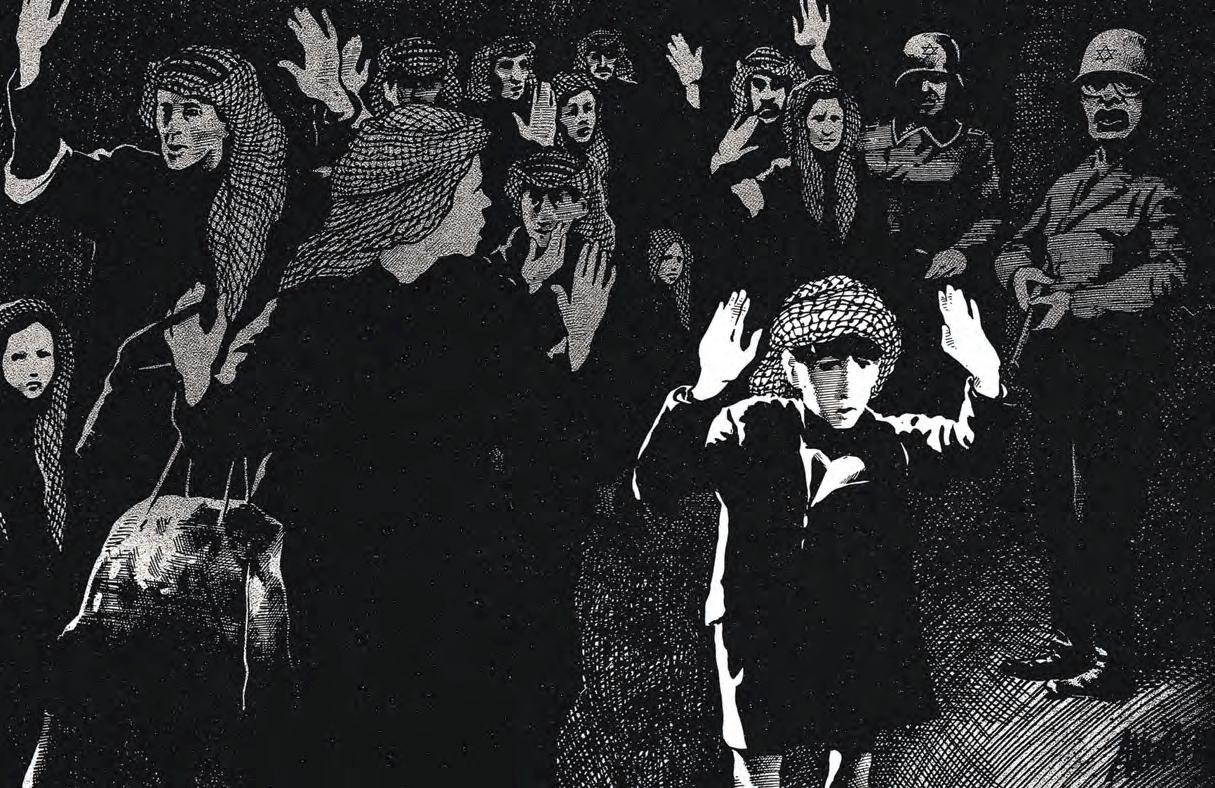
O GUETO DE VARSÓVIA EM CHATILA – 1982
Em setembro de 1982, centenas ou milhares (o número é incerto) de palestinianos são massacrados indiscriminadamente nos campos de refugiados de Sabra e Chatila, no Sul do Líbano. A chacina é levada a cabo por milícias cristãs libanesas, numa zona então controlada pelos militares de Israel. O cartoon recria a célebre foto do menino judeu expulso, em 1943, por tropas nazis, do gueto de Varsóvia. E recebeu o Grande Prémio do Salon International de Cartoon de Montréal, Canadá, em 1983
THE WARSAW GHETTO IN SHATILA – 1982
In September 1982, hundreds or thousands (the number is uncertain) of Palestinians are indiscriminately massacred in the refugee camps of Sabra and Shatila, in southern Lebanon. The slaughter is carried out by Lebanese Christian militias, in an area controlled by Israel’s soldiers. The cartoon recreates the famous photo of the Jewish boy thrown out by Nazi troops from the Warsaw ghetto in 1943. It won the Grand Prix at the Salon International de Cartoon in Montréal, Canada, in 1983
1985-1994
DO DESMORONAMENTO DA URSS AO MASSACRE DE TIANANMEN, DO FIM DO APARTHEID AO COLAPSO DE PINOCHET FROM THE COLLAPSE OF THE USSR TO THE TIANANMEN MASSACRE, FROM THE END OF APARTHEID TO PINOCHET’S COLLAPSE

Acabado de ser reeleito presidente, no final de 1984, com uma vitória esmagadora em 49 dos 50 estados dos EUA, Reagan beneficia da crise do império soviético para afirmar a hegemonia norte-americana na cena mundial
FOOTBALL – 1985
Having just been re-elected President at the end of 1984, with a landslide victory in 49 of the 50 USA states, Reagan benefits from the Soviet empire’s crisis to assert USA hegemony on the world stage
GORBACHEV – 1985
Eleito secretário-geral do PCUS e líder da URSS em 1985, aos 54 anos, Mikhail Gorbachev surpreende o mundo pelo seu espírito de mudança, advogando a perestroika (reforma) e a glasnost (abertura) do regime soviético, que acabará por se desmoronar. A característica mancha de vasos capilares na sua cabeça faz lembrar que, com ele, mudou a política mundial
GORBACHEV – 1985
Elected Secretary-General of the USSR Communist Party and USSR leader in 1985 at the age of 54, Mikhail Gorbachev surprised the world with his spirit of change, advocating perestroika (reform) and glasnost (opening up) of the Soviet regime, which would eventually collapse. The characteristic spot of capillary blood vessels on his head is a reminder that, with him, world politics has changed

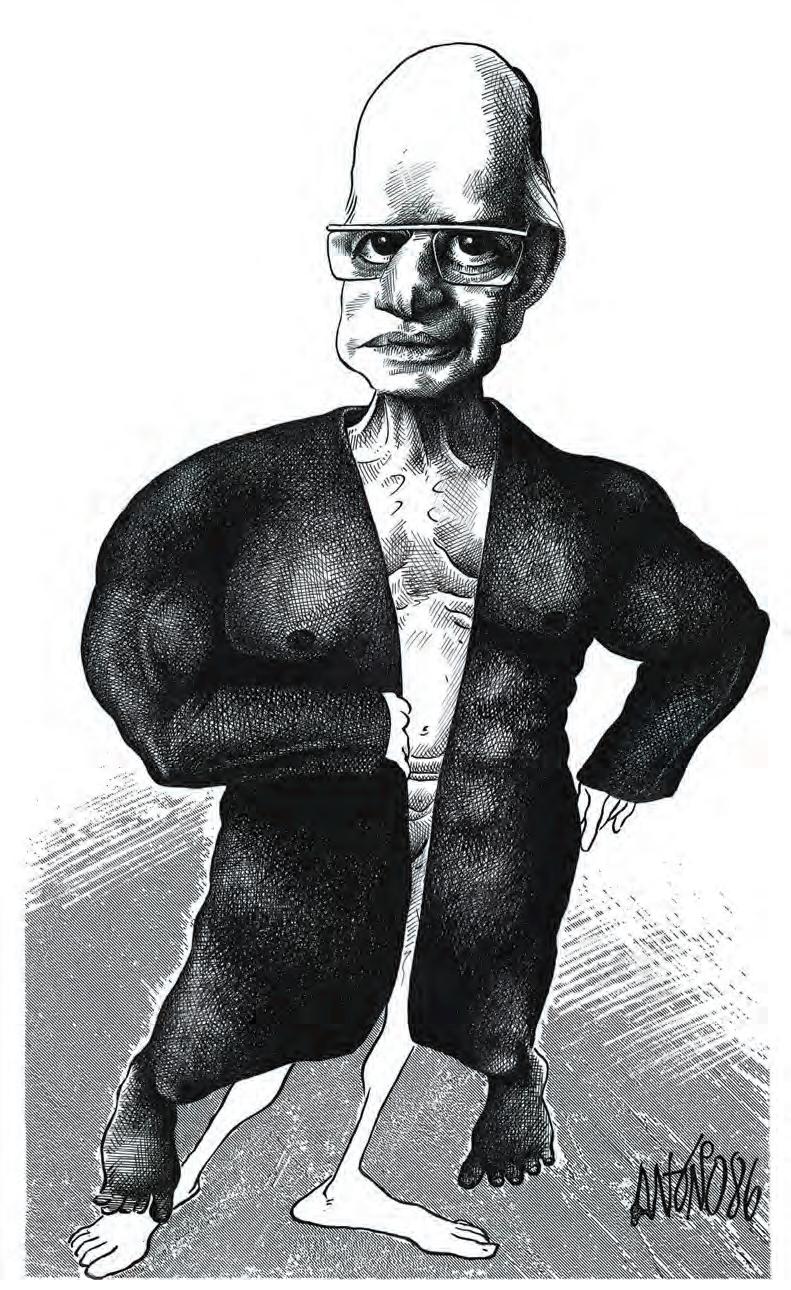
PRETO E BRANCO – 1986
Pieter W. Botha foi a face do poder nos últimos anos do regime racista de apartheid na África do Sul (imposto em 1948 e extinto por referendo em 1992). Ministro da Defesa (1966-78), primeiro-ministro (1978-84) e presidente (1984-89), Botha nunca abandonou as ideias segregacionistas e da supremacia branca
BLACK AND WHITE – 1986
Pieter W. Botha was the face of power in the final years of South Africa’s racist apartheid regime in South Africa (imposed in 1948 and abolished by referendum in 1992). Minister of Defense (196678), Prime Minister (1978-84) and President (1984-89), Botha never abandoned segregationist and white supremacy ideas
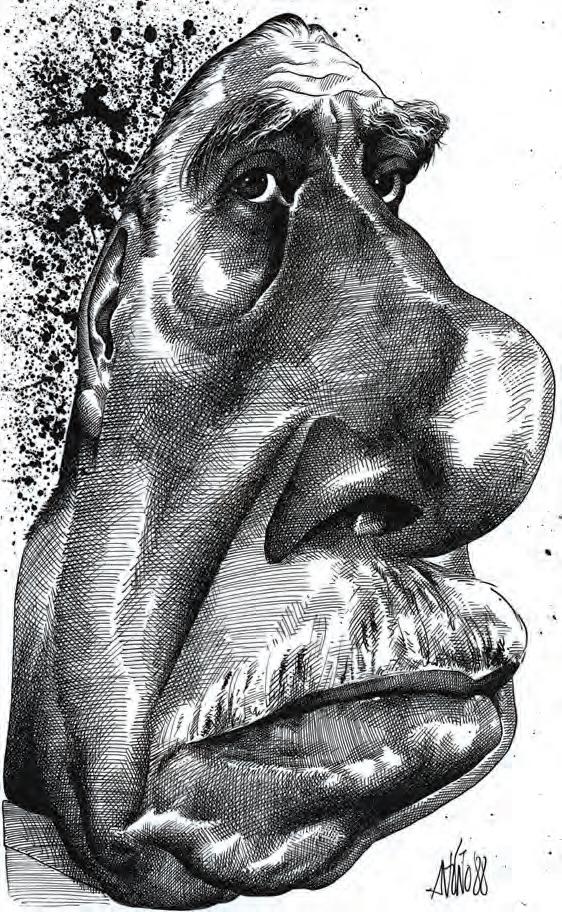
PINOCHET I – 1988
PINOCHET II – 1988
O general e ditador Augusto Pinochet, no poder desde o golpe militar que derrubou o Presidente Allende no Chile a 11 de setembro de 1973, perde em 1988 o plebiscito que pretendia prolongar o seu mandato até 1997 (o Não venceu com 56%). Acabaria por sair do poder em 1990, deixando atrás de si um rasto de 80 mil presos políticos, 30 mil torturados e mais de 3 mil assassinados
PINOCHET I – 1988
PINOCHET II – 1988
General and dictator Augusto Pinochet, in power since the military coup that overthrew President Allende in Chile on 11 September 1973, lost the plebiscite in 1988 that sought to extend his mandate until 1997 (the No won with 56%). He ended up leaving power in 1990, leaving behind a trail of 80,000 political prisoners, 30,000 tortured persons and more than 3,000 murdered
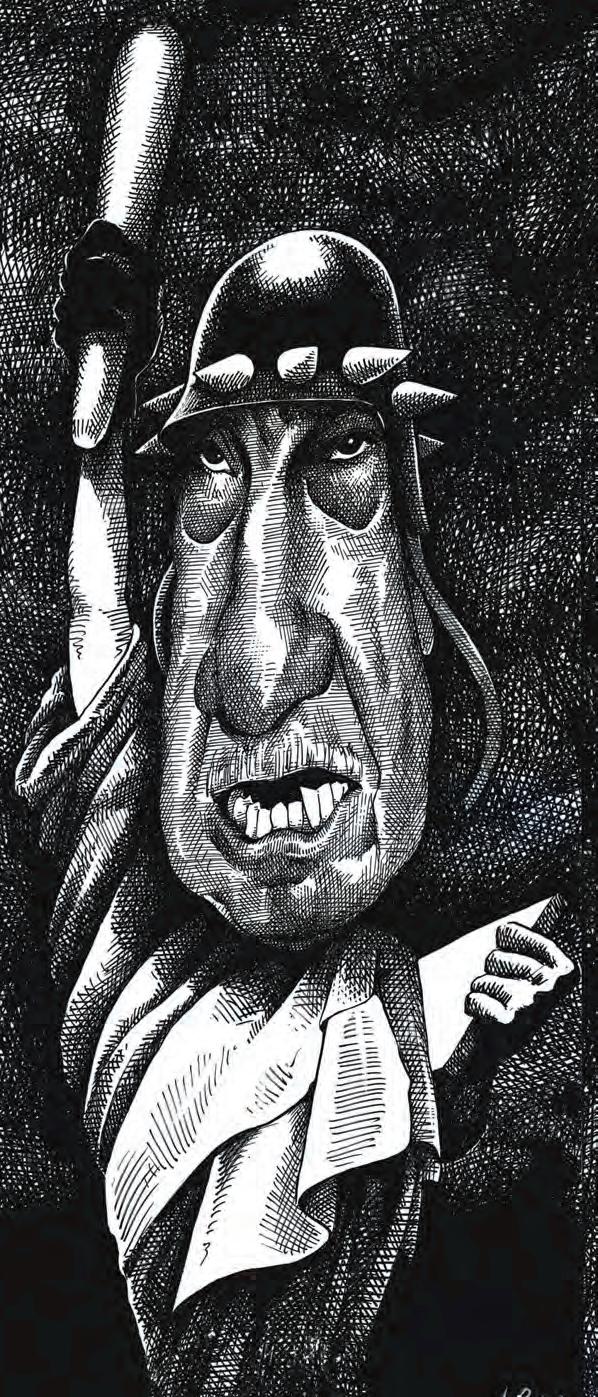

MAO TSÉ-TUNG – 1989
A 4 de junho de 1989, o Governo chinês ordena aos militares que carreguem contra os manifestantes, na maioria estudantes, que ocupam em protesto a Praça Tiananmen, a maior de Pequim, onde se destaca a imagem póstuma de Mao. Calcula-se que tenham morrido cerca de 10 mil manifestantes, no massacre conduzido pelos tanques e veículos do Exército. Os protestos por liberdade e democracia iniciaram-se em abril, a lei marcial foi decretada em maio e o movimento terminou no banho de sangue de 4 de junho
MAO TSÉ-TUNG – 1989
On 4 June 1989, the Chinese government ordered the military forces to charge against demonstrators, most of them students, who were occupying Tiananmen Square, Beijing’s largest square, where the posthumous image of Mao stands. It is estimated that around 10,000 demonstrators died in the massacre carried out by tanks and army vehicles. The protests for freedom and democracy began in April, martial law was decreed in May and the movement ended in the bloodshed of 4 June

DENG XIAOPING – 1989
Deng Xiaoping assume o papel de grande reformador da antiquada economia da China ao ocupar a liderança do país entre 1978 e 1992. Instaura em amplos setores a economia de mercado e o capitalismo de partido único. Mas impede as reformas políticas e os ventos de abertura que sopram da URSS de Gorbachev, reprimindo duramente manifestações como as que desembocaram no massacre de Tiananmen
DENG XIAOPING – 1989
Deng Xiaoping took on the role of the great reformer of China’s antiquated economy when he took over the leadership of the country between 1978 and 1992. He established a market economy and the one-party capitalism in large sectors. But he hindered the political reforms and the winds of openness blowing from Gorbachev’s USSR, harshly repressing demonstrations such as those that led to the Tiananmen massacre
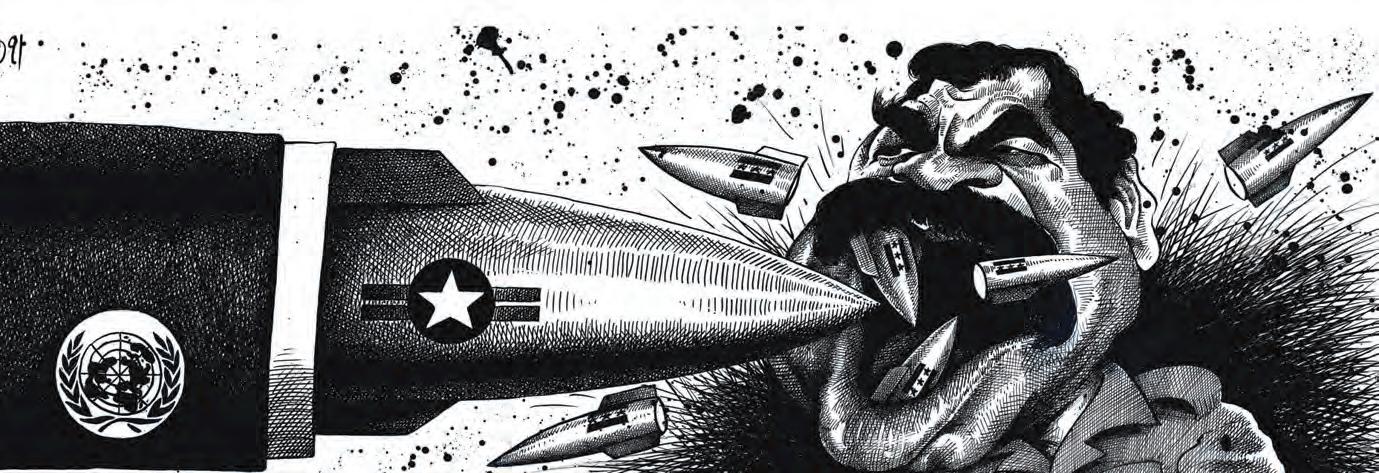
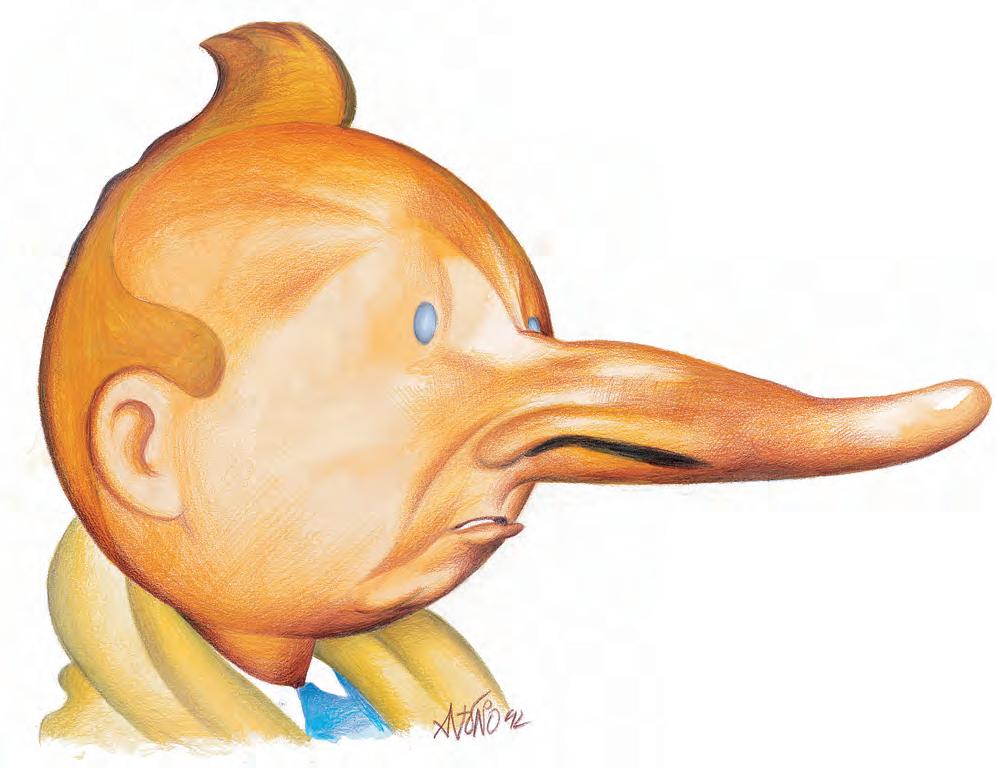
GUERRA NO GOLFO – 1991
No início de agosto de 1990, o Iraque de Saddam Hussein invadiu o vizinho Kuwait e anexou o território rico em petróleo. No dia 16 de janeiro de 1991 uma poderosa força militar de vários países liderada pelos EUA entrou no Iraque e derrotou, em pouco mais de seis semanas, as tropas que Saddam proclamava serem invencíveis. A 24 de fevereiro terminava a Guerra do Golfo, com mais de 20 mil soldados iraquianos mortos no conflito
GULF WAR – 1991
At the starting of August 1990, Saddam Hussein’s Iraq invaded neighboring Kuwait and annexed the oil-rich territory. On 16 January 1991, a powerful USA-led military force from several countries entered Iraq and defeated the troops that Saddam claimed to be invincible in just a little over six weeks. On 24 February the Gulf War has ended, with more than 20,000 Iraqi soldiers killed in the conflict
DELORS – 1992
Jacques Delors, o francês presidente da Comissão Europeia (1985-95), consegue em 1992 fazer aprovar o Tratado de Maastricht, que estabelece os princípios fundamentais da União Europeia, com o mercado único e a livre circulação, bem como uma política externa e de segurança comum. O Tratado de Maastricht substitui todos os tratados europeus anteriores
DELORS – 1992
In 1992, Jacques Delors, the French president of the European Commission (1985-95), succeeded in getting the Maastricht Treaty approved, establishing the fundamental principles of the European Union, with a single market and free circulation, as well as a common foreign and security policy. The Maastricht Treaty replaces all previous European
C EST LA FÔTE À BRUXELLES! (CENTRE WALLONIE-BRUXELLES, PARIS, FRANÇA, 2010)

KHOMEINI – 1989
Em 1989, dez anos depois de assumir o poder, morre em Teerão o líder religioso Ayatollah Khomeini, com 86 anos. Viveu no exílio de 1964 a 1979, voltando ao Irão para dirigir a revolução que derrubou o Xá Reza Pahlavi. Consagrado como primeiro líder supremo do Estado Islâmico do Irão, impôs uma feroz ditadura religiosa xiita responsável por incontáveis execuções e massacres dos seus opositores
KHOMEINI – 1989
In 1989, ten years after taking power, the religious leader Ayatollah Khomeini died in Tehran at the age of 86. He lived in exile from 1964 to 1979, returning to Iran to lead the revolution that overthrew Shah Reza Pahlavi. Established as the first Supreme Leader of the Islamic State of Iran, he imposed a ferocious Shiite religious dictatorship responsible for countless executions and massacres of his opponents

ENXAQUECA – 1991
Após a queda do Muro de Berlim em 1989 e face ao desmembramento em curso de várias repúblicas soviéticas, a ala mais conservadora do PCUS lança um golpe de Estado em Moscovo para depor Gorbachev e inverter o rumo dos acontecimentos. O golpe, entre 19 e 21 de agosto, acaba por fracassar. Mas Gorbachev também sai fragilizado desse confronto: abandona a liderança do PCUS dois dias depois
MIGRAINE – 1991
Following the fall of the Berlin Wall in 1989 and the ongoing break-up of several Soviet republics, the most conservative wing of the USSR Communit Party launches a putsch in Moscow to oust Gorbachev and reverse the course of events. The putsch, which took place between 19 and 21 August, ended up in failure. But Gorbachev also emerged weakened from this confrontation: he left the leadership of the USSR Communist Party two days later
A VACA DA ECONOMIA – 1992
Após os 30 anos de grande crescimento económico do pós-guerra e ultrapassada a crise petrolífera dos anos 70, o colapso do bloco socialista liderado pela URSS vem consagrar o capitalismo e a economia de mercado como grandes triunfadores num mundo cada vez mais globalizado
THE COW OF ECONOMY – 1992
After 30 years of great post-war economic growth and after the oil crisis of the 1970s, the collapse of the socialist bloc led by the USSR established capitalism and the market economy as the great winners in an increasingly globalised world



